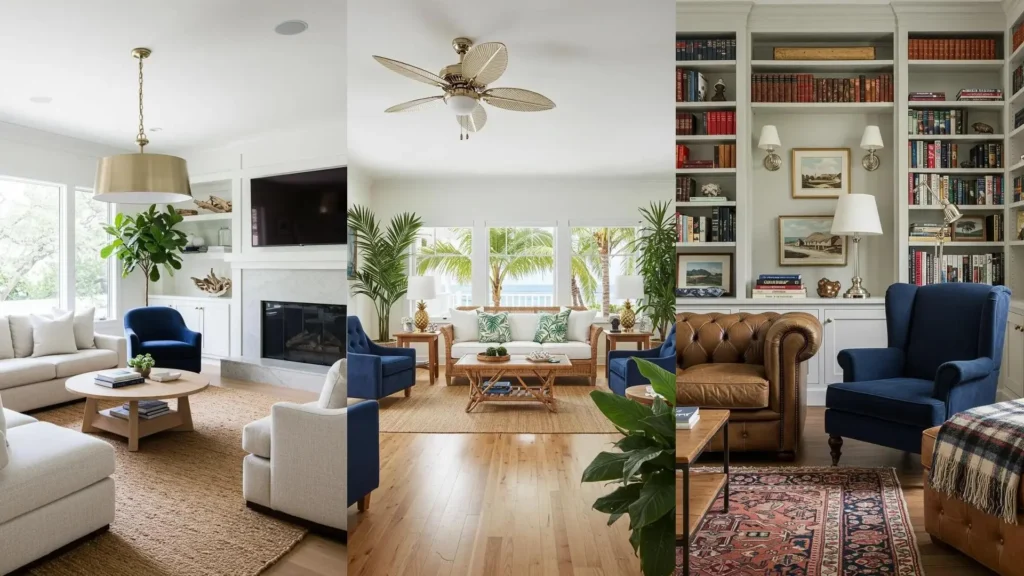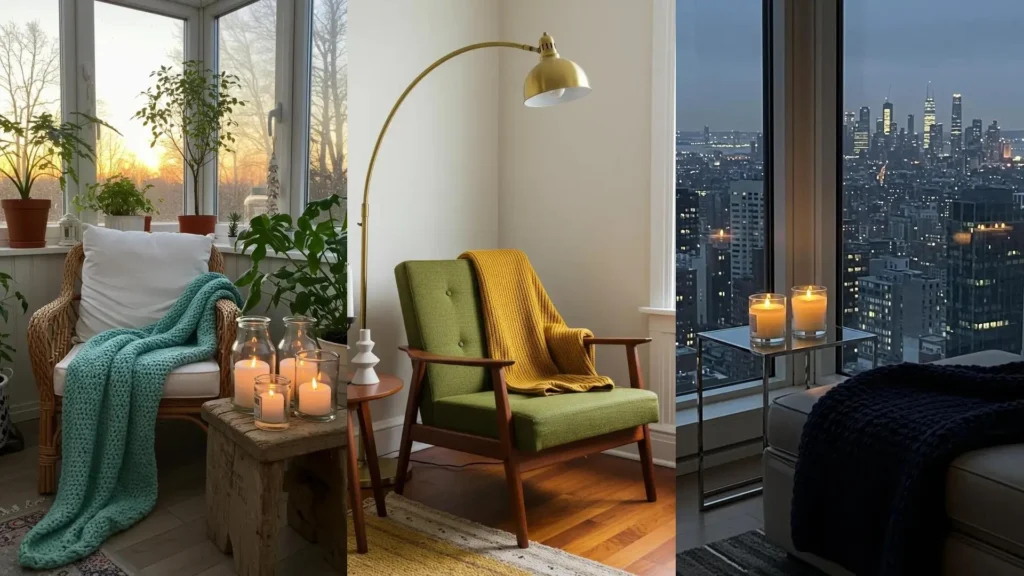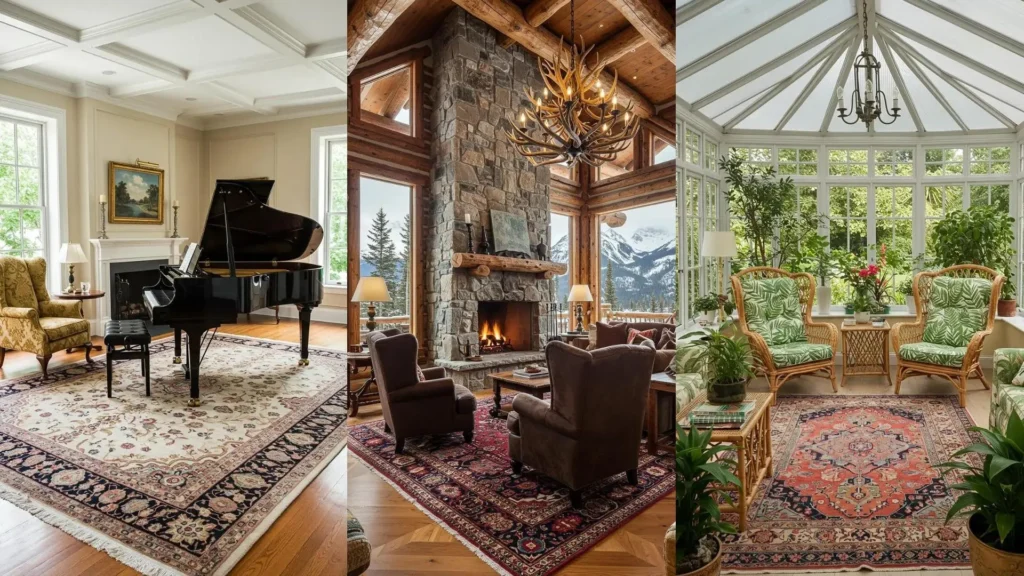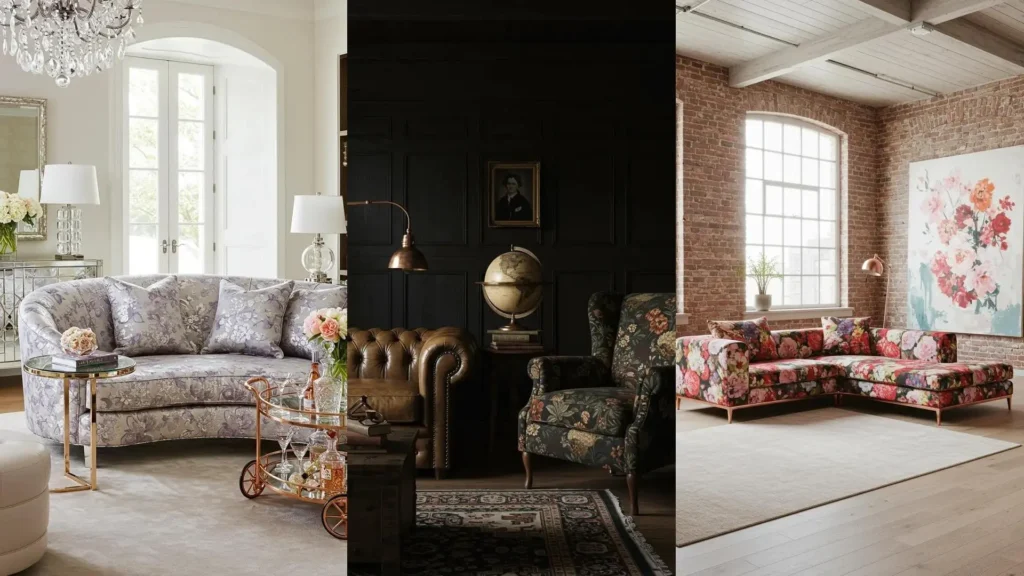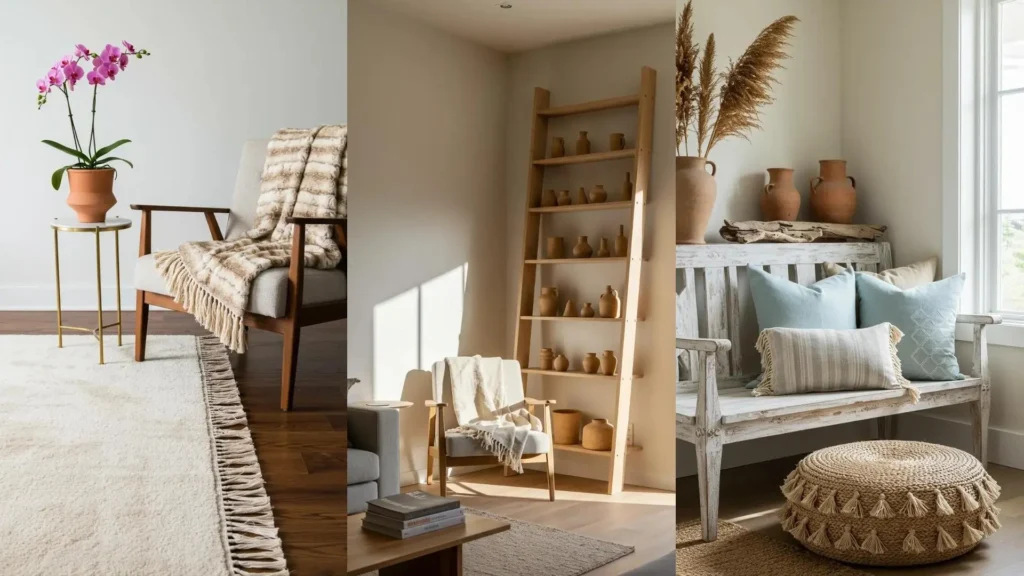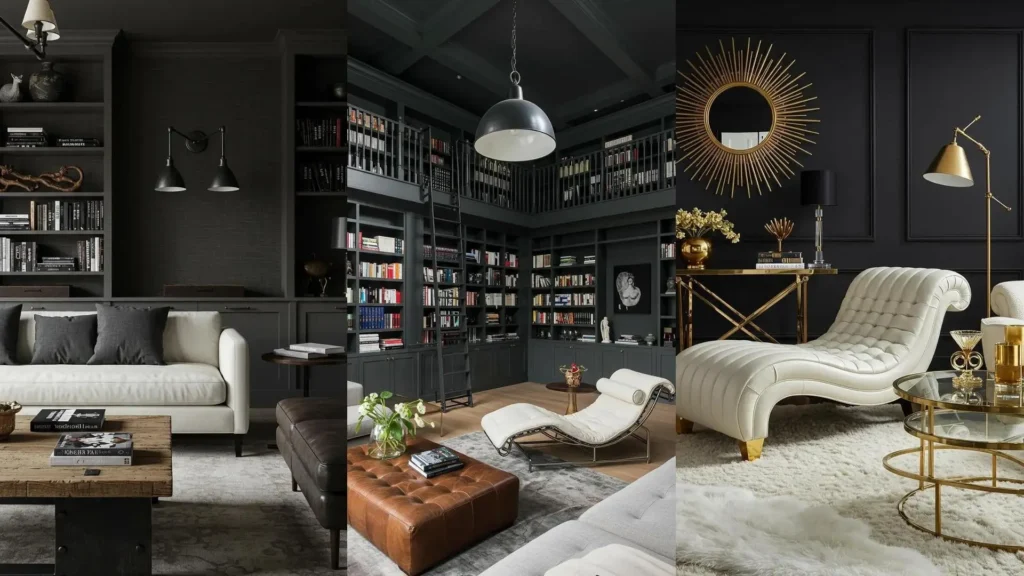Creating a living room that feels both beautiful and genuinely yours is not about grand gestures or fleeting trends. It’s about thoughtful choices—selecting materials that tell a story, arranging furniture to invite connection, and understanding how texture and light can shape your mood.
This is where sustainable design truly shines. Reclaimed wood, organic linens, and handcrafted pieces bring a warmth and soul that mass-produced items simply cannot replicate. They connect your home to the natural world and carry a sense of history and intention.
Here, I will guide you through small, meaningful adjustments you can make right now. Think of this not as a set of rules, but as a series of calm, clear invitations to see your space with new eyes and make it a more authentic reflection of you.
1. Layer Tonal Textures for Calm Sophistication
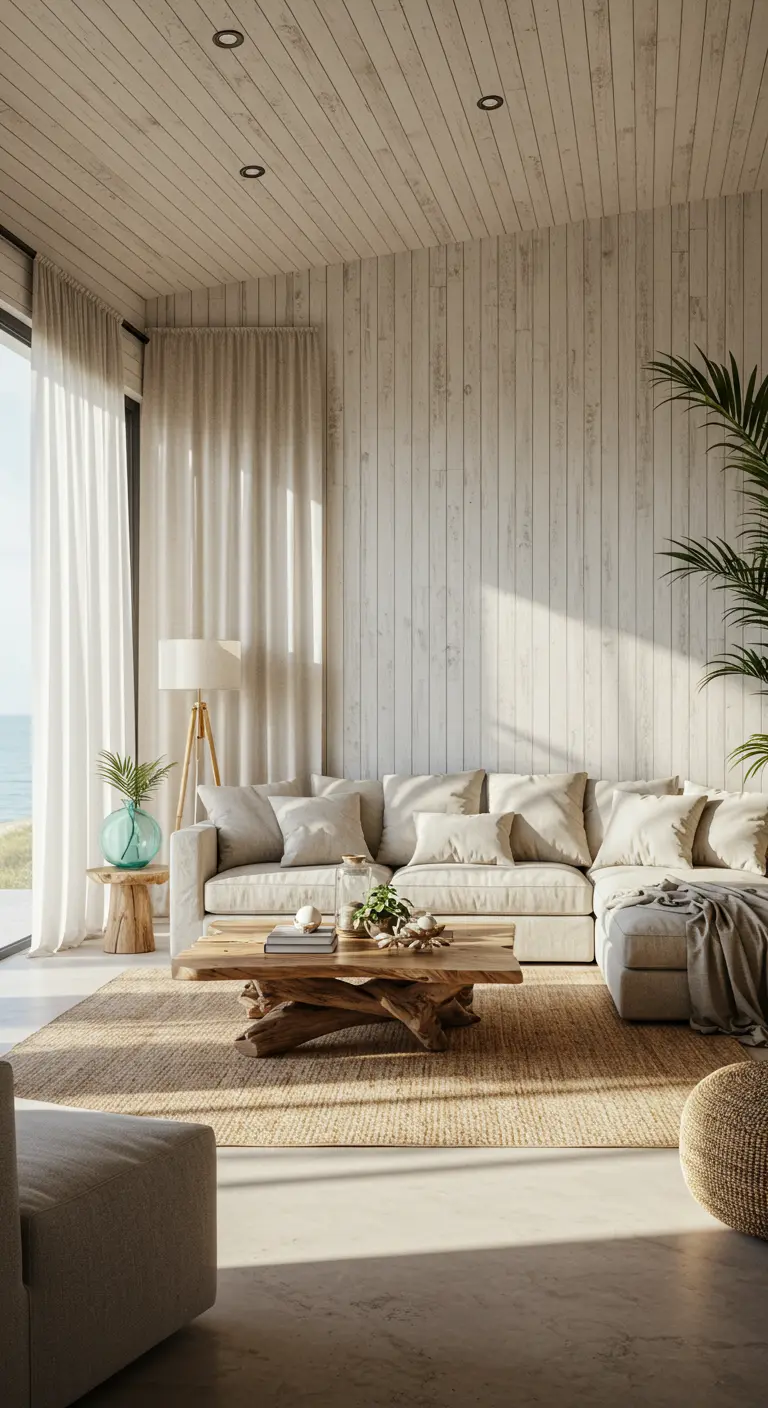
Create a serene, layered look by using materials of the same color family but with different textures.
Pair the nubby weave of a jute rug with the soft, rumpled surface of organic linen slipcovers.
Introduce a sculptural coffee table made from reclaimed driftwood to serve as the room’s organic centerpiece.
The subtle variations in texture add visual depth and warmth without overwhelming the space with color, achieving a timeless coastal chic that feels both elevated and relaxed.
2. Embrace the Architecture of a Cozy Nook

In a room with dramatic architecture like an A-frame, lean into the cozy, enclosing feeling rather than fighting it.
Choose a dark, deep sectional that anchors the space and invites you to settle in.
Balance the visual weight of the wood-paneled ceiling and floors with exceptionally soft textures, like a chunky knit throw and a faux hide rug.
This creates a protected, intimate retreat, perfect for a cozy winter-inspired sanctuary.
3. Use a Paper Lantern to Soften Clean Lines
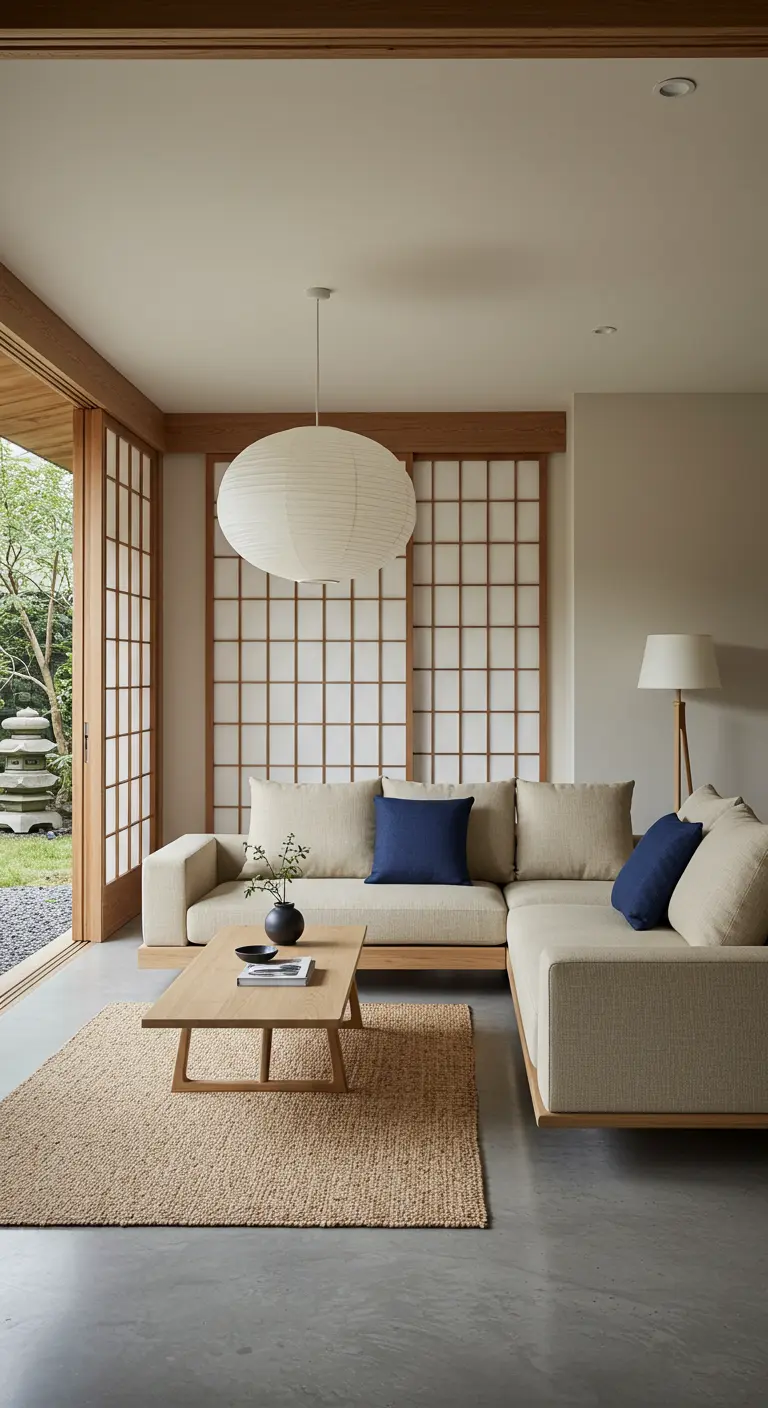
In a space defined by crisp, geometric forms, a single soft element can completely rebalance the room.
Suspend a large, paper-shaded pendant light to introduce a gentle, sculptural curve that contrasts beautifully with the grid of shoji screens and the sharp lines of the sofa.
This one change adds a touch of organic softness and provides diffused, flattering light, embodying the principles of Japandi interior design.
4. Warm Industrial Elements with an Earthy Hue
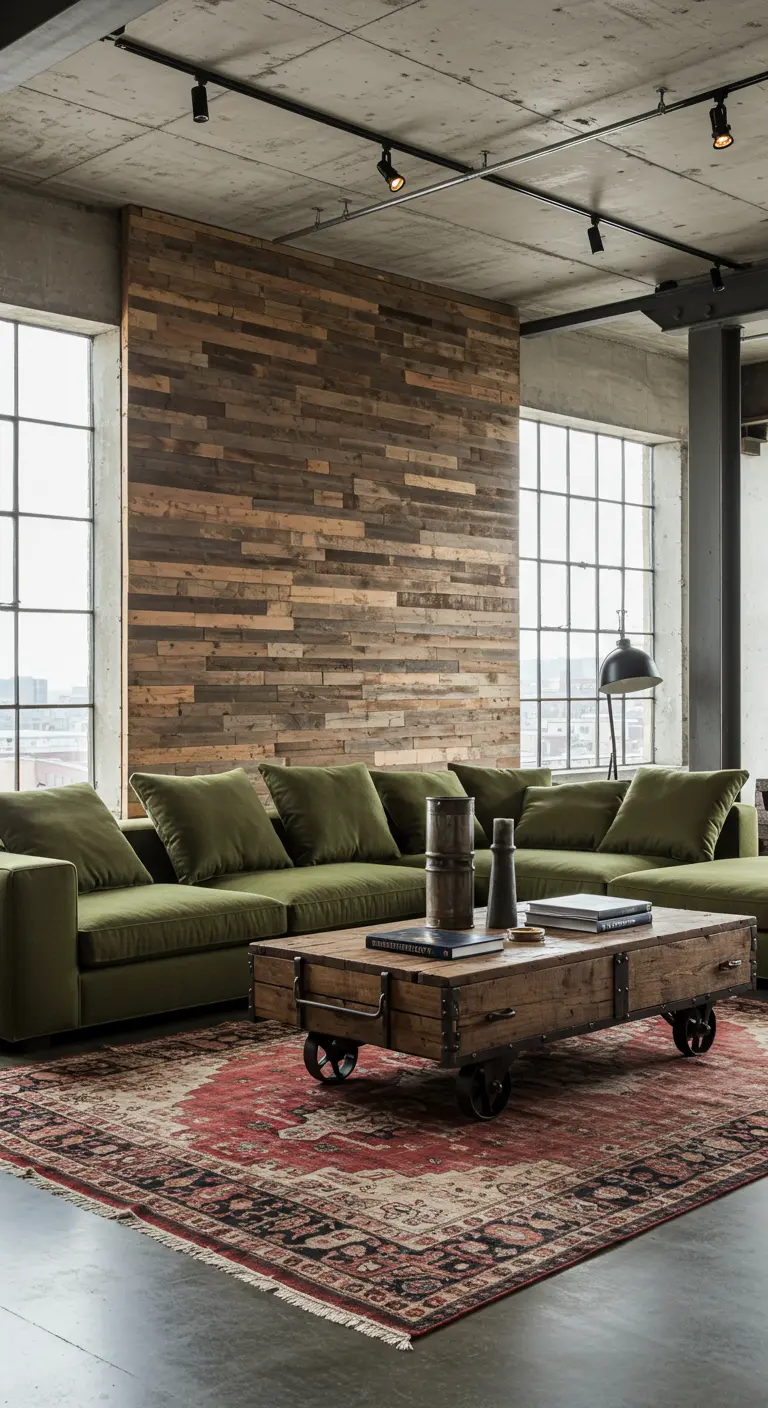
To prevent an industrial space with concrete floors and exposed beams from feeling cold, introduce warmth through both color and material.
An olive green sofa provides a rich, grounding color that connects the interior to nature.
Pair it with a reclaimed wood accent wall; the varied tones and textures of the wood planks add history and character, beautifully offsetting the raw, modern architecture.
This fusion of rugged and refined is central to modern rustic hybrids.
5. Style with Plants as Living Sculpture

In a minimalist, all-white room, plants do more than just add a splash of color—they provide organic shape and life.
Group several plants of varying heights and leaf shapes together to create a dynamic green focal point.
Use simple, terracotta pots for a cohesive and earthy feel that grounds the airy space.
This approach turns your greenery into a deliberate design element, preventing a chic Scandinavian minimalist space from feeling stark.
6. Center the Room with an Artisanal Fireplace
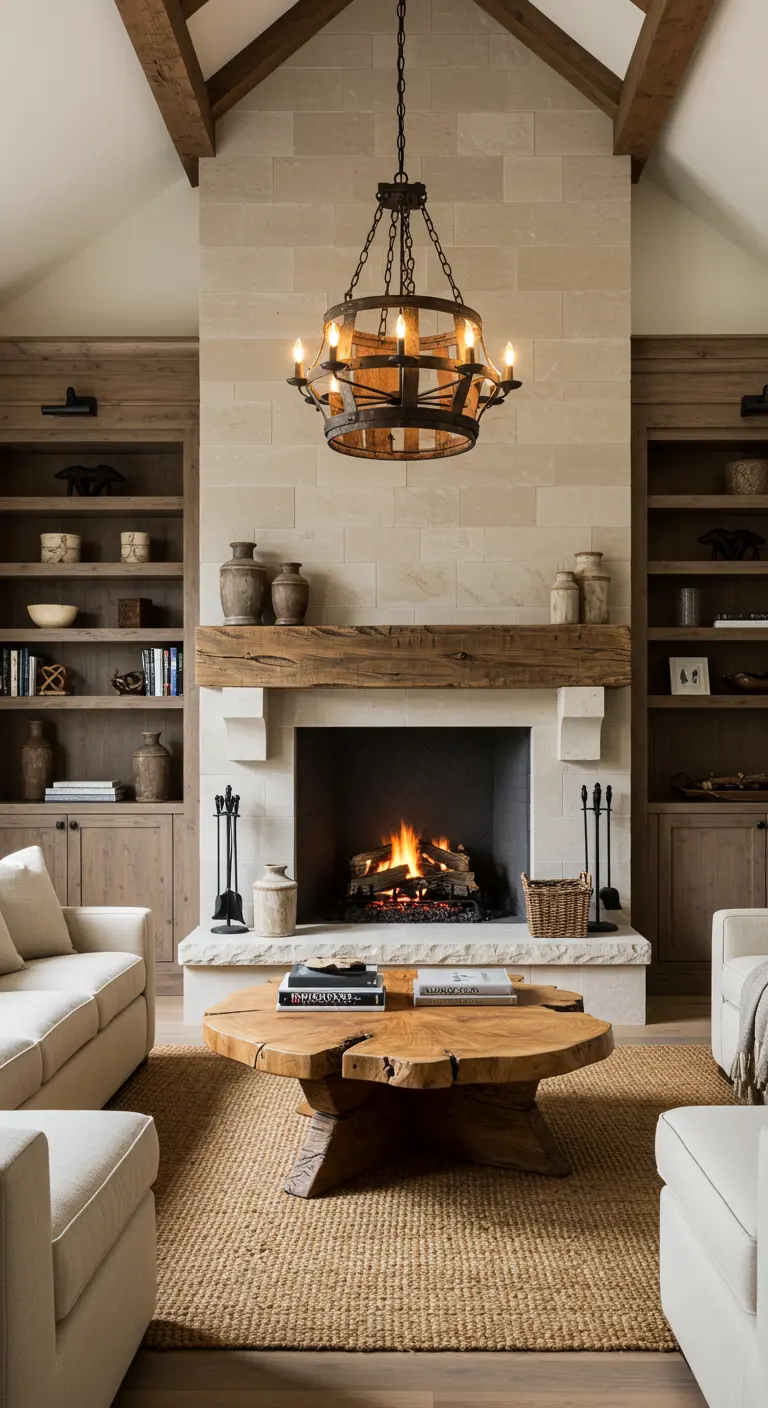
Make your fireplace the undisputed heart of the home by framing it with natural, substantial materials.
A thick, reclaimed wood mantel provides a rustic, grounding line above the firebox.
Surround it with limestone or travertine tiles, whose soft, earthy tones complement the wood and add quiet luxury.
This focus on craftsmanship and quality materials elevates the entire room, turning a simple fireplace into a true architectural statement, reminiscent of a modern farmhouse aesthetic.
7. Elevate a Pallet Table with Intentional Styling
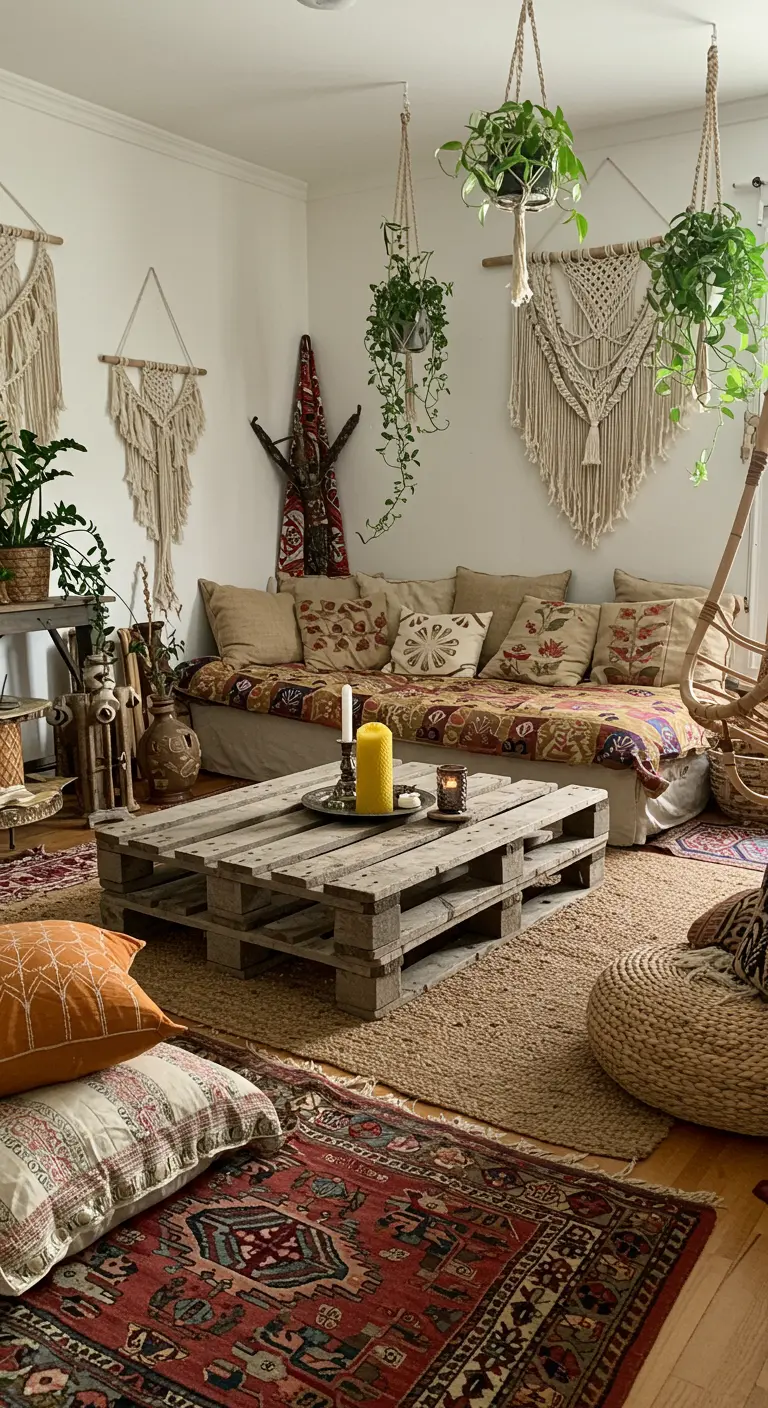
A DIY pallet coffee table can look chic and intentional, not like a temporary fix.
The key is to sand the wood thoroughly for a smooth finish and ensure the construction is neat and level.
Surround it with low, comfortable seating like floor cushions and layered rugs to create a relaxed, communal atmosphere.
This approach fully embraces a boho-chic interior vibe, turning a humble object into the heart of the space.
8. Balance a Dark Palette with Warm Metallics
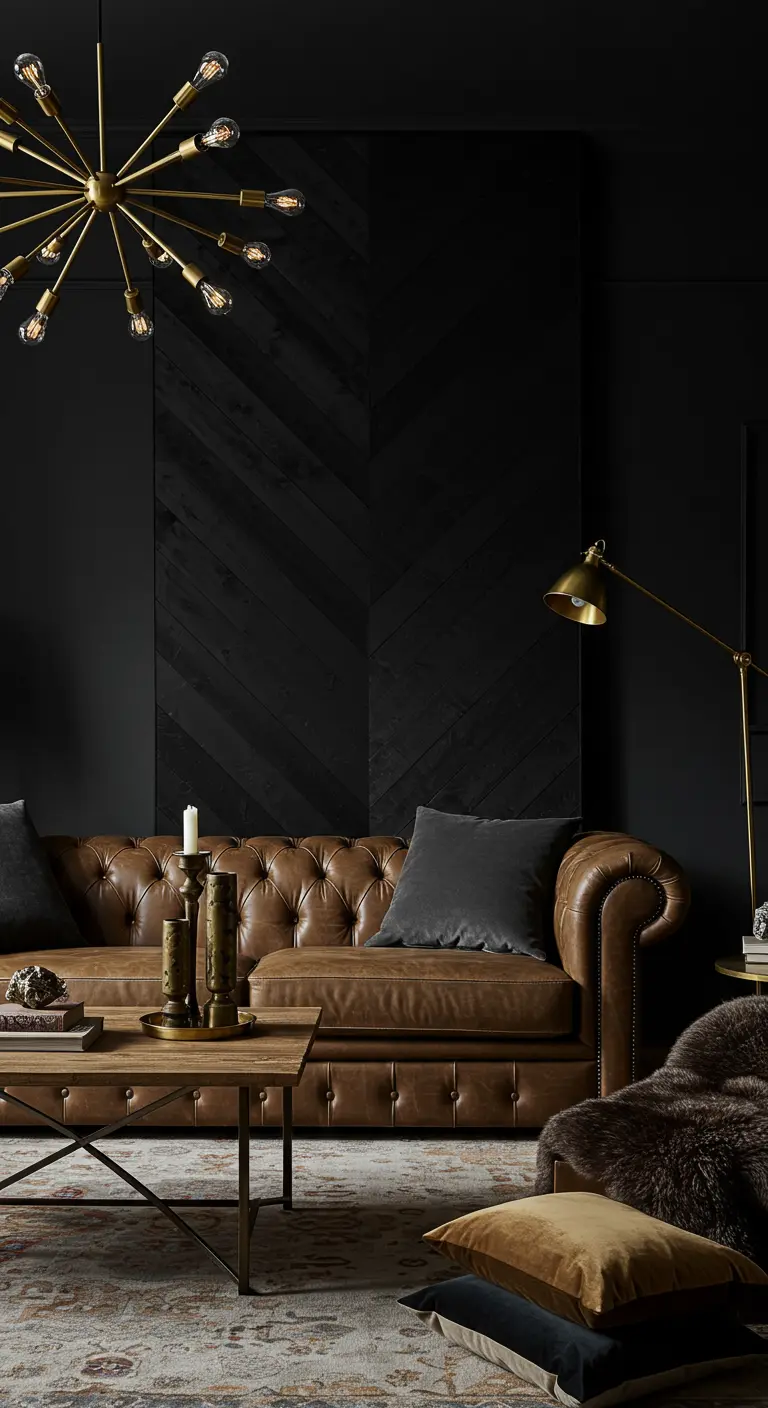
A dark, moody room feels luxurious, not somber, when you introduce points of light and warmth.
Against a black shiplap wall, a tufted leather chesterfield provides a rich, classic texture.
The crucial element is brass: a sculptural sputnik chandelier and a slender floor lamp act like jewelry, catching the light and breaking up the darkness.
This high-contrast approach creates a dramatic yet inviting atmosphere, perfect for moody interiors.
9. Use Textile Art for Soft, Organic Focus

Instead of a traditional framed print, hang a piece of textile art, like an indigo-dyed wall hanging, to add softness and texture.
The unframed fabric and raw edges complement the relaxed feel of a linen slipcovered sofa and rustic wood floors.
Position it off-center to create a more casual, undone look.
This is a simple way to introduce pattern and color that feels integrated and gentle, aligning with a wabi-sabi style.
10. Add Warmth and Soundproofing with Cork
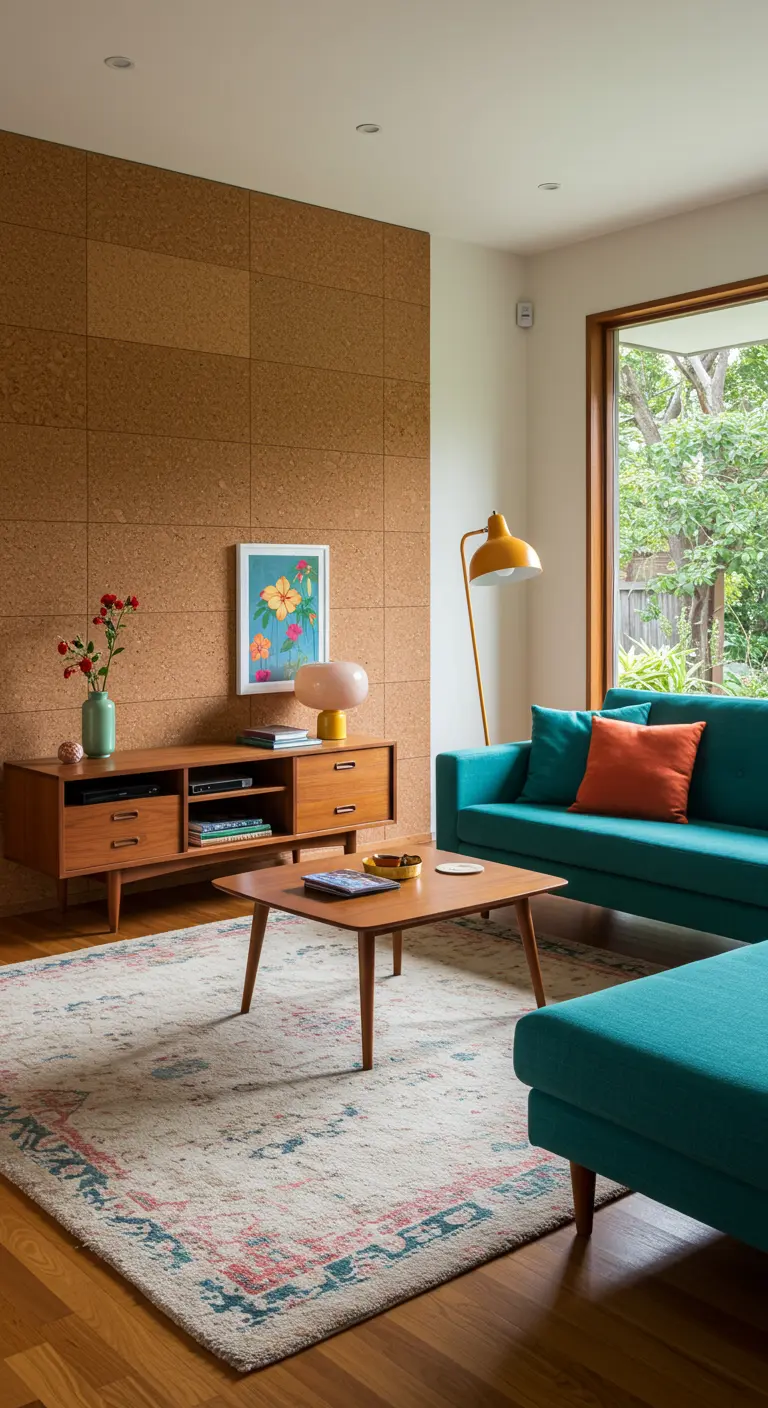
For an accent wall that is both visually and functionally warm, consider cork tiles.
Cork is a sustainable, renewable material that provides excellent acoustic and thermal insulation, making your living room quieter and more comfortable.
Its natural, mottled texture creates a soft, earthy backdrop that pairs beautifully with the clean lines of mid-century modern looks and vibrant colors.
11. Design a Sunken Seating Area for Intimacy
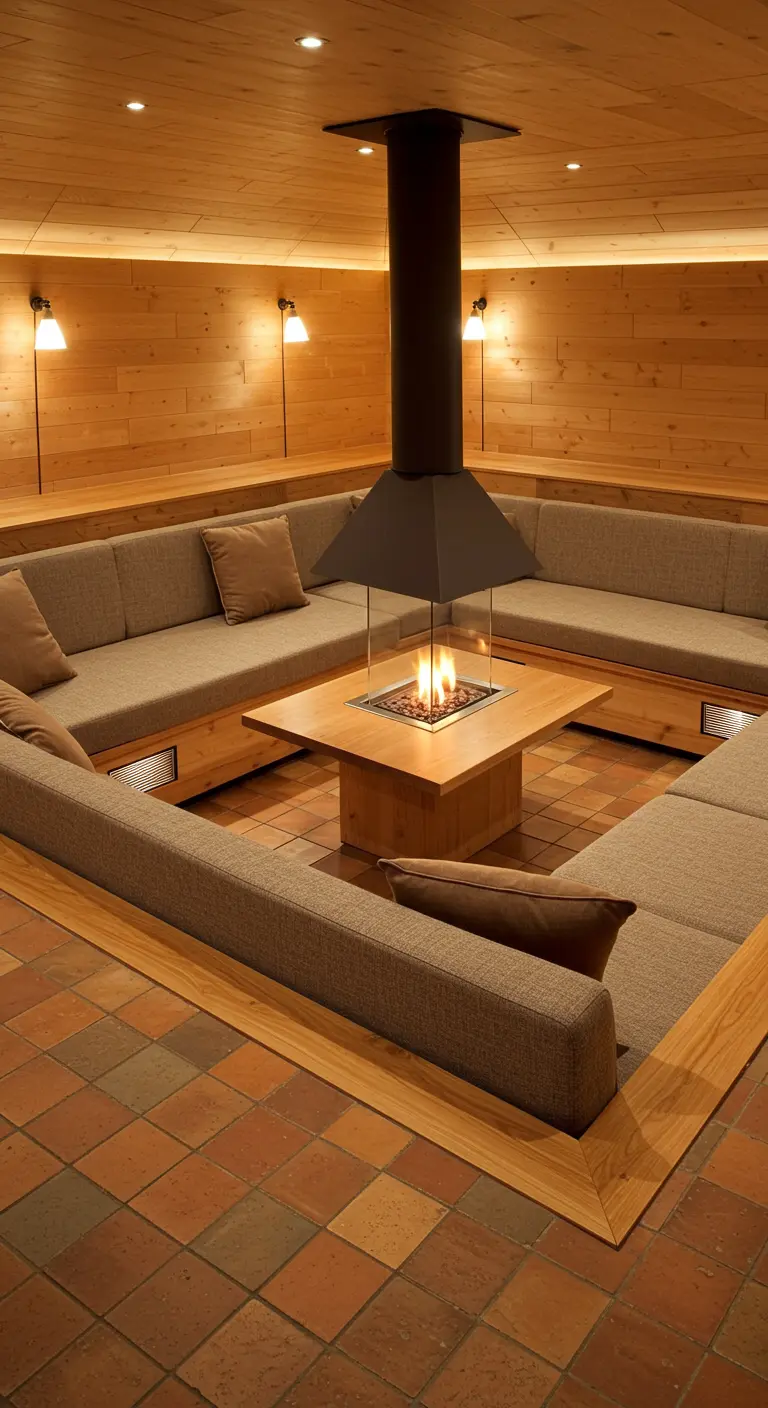
Create a dedicated zone for conversation by designing a sunken living room, or a ‘conversation pit’.
This layout physically separates the lounge area from the rest of the home, fostering a unique sense of intimacy and focus.
Line the built-in seating with durable, comfortable upholstery and center it around a contained fire feature for the ultimate gathering spot.
It’s a retro concept that feels incredibly modern and communal, perfect for hygge-inspired entertaining.
12. Go Oversized with Lighting in a Vaulted Room
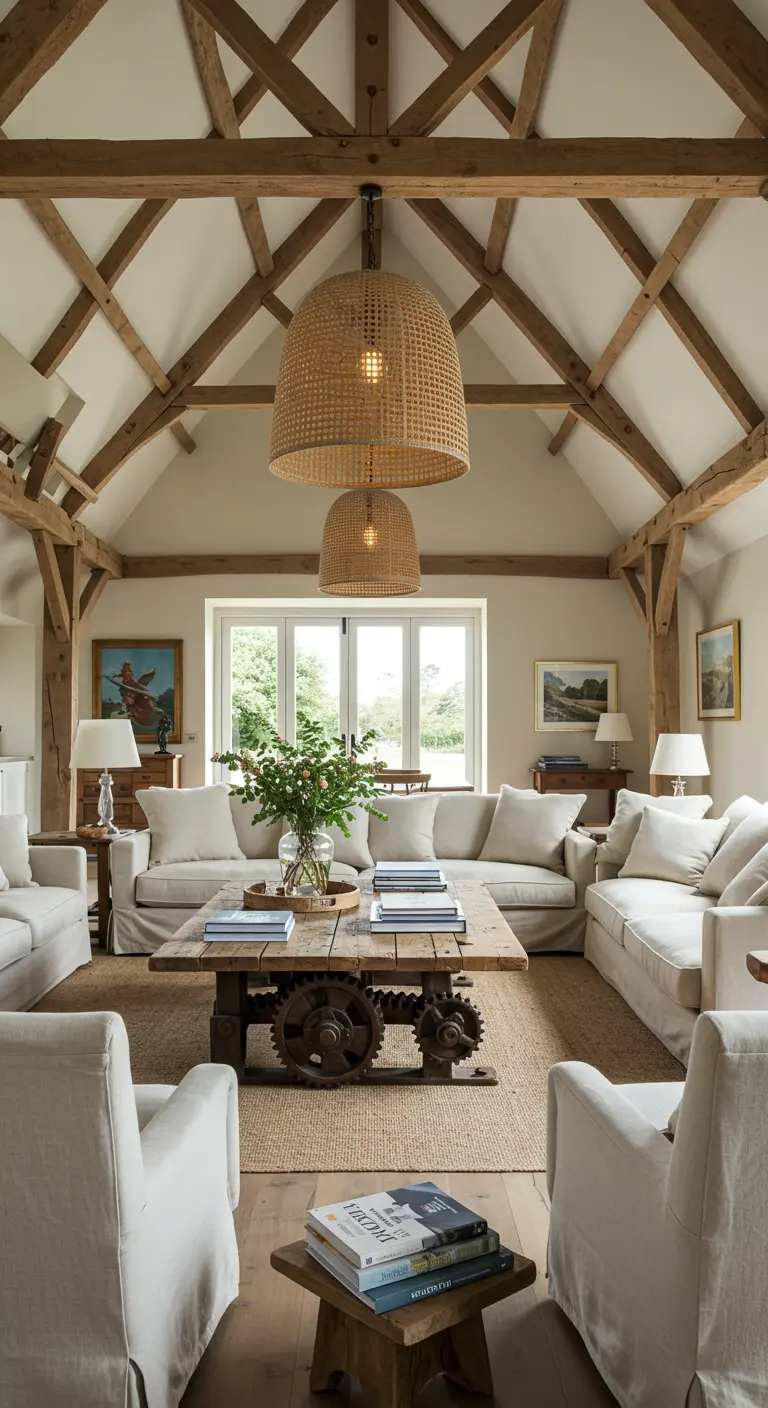
In a room with high, vaulted ceilings and exposed beams, standard-sized fixtures will get lost.
Choose oversized, statement-making pendant lights, like these large woven rattan drums, to fill the vertical space appropriately.
Hanging them at different heights adds visual interest and helps to bring the ceiling down, making the seating area feel more intimate and grounded.
This move is about scaling your decor to match the room’s architecture, a key principle in creating light-filled farmhouse rooms.
13. Frame the View as Your Primary Artwork
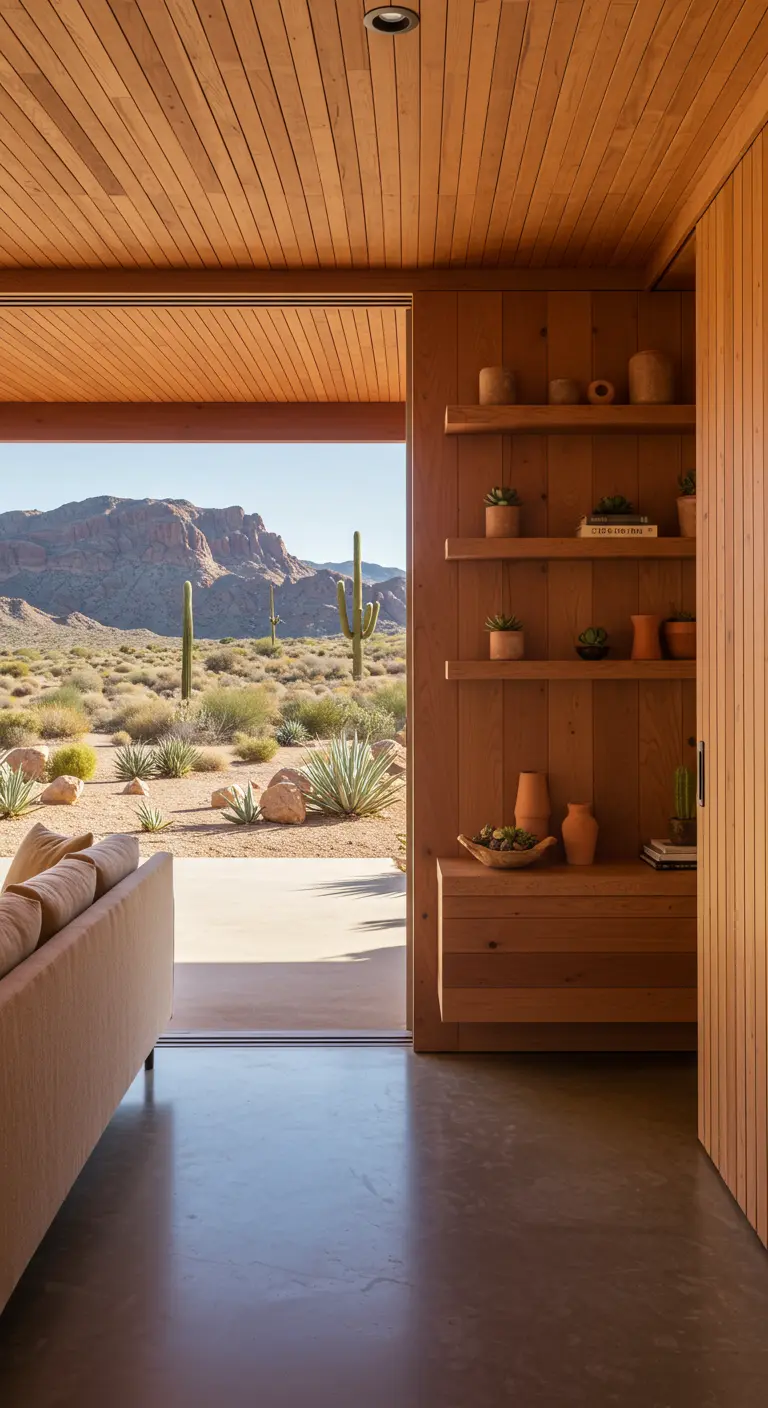
When you have a spectacular view, the most important design choice is to let it take center stage.
Use a floor-to-ceiling glass wall or sliding door to eliminate any barrier between your living space and the landscape outside.
Keep the interior palette simple and natural—warm wood paneling and a neutral sofa—so that nothing competes with the view.
The natural scenery becomes the room’s dynamic, ever-changing art, a hallmark of desert-inspired interiors.
14. Create a Living Wall for a Dramatic Statement
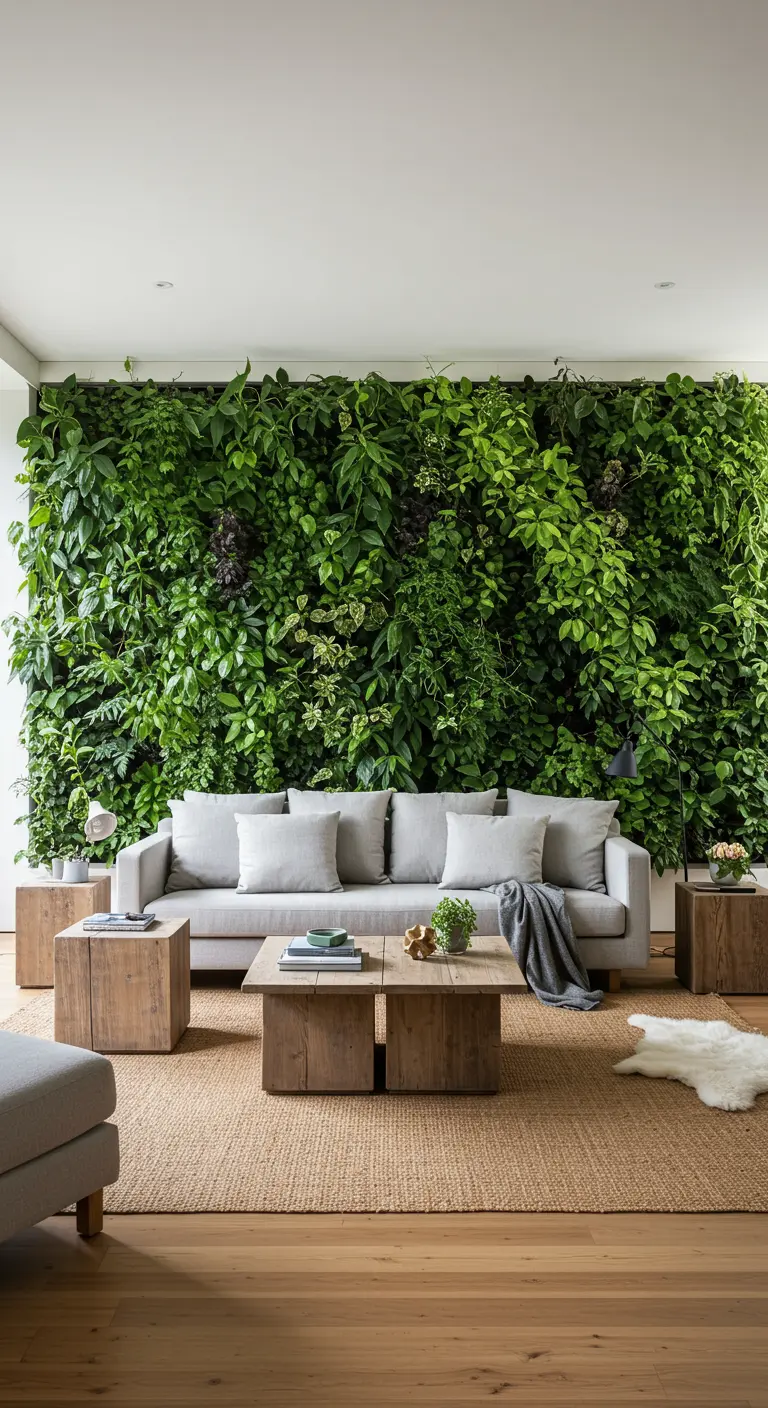
For the ultimate connection to nature, dedicate an entire wall to a vertical garden.
A living wall acts as a stunning piece of biological art, improves air quality, and can even help to dampen sound.
Keep the surrounding furniture simple and low-profile—a neutral sofa, blocky wood tables—to ensure the wall remains the hero of the space.
You can start with modular vertical garden wall decor kits to make this ambitious project more manageable.
15. Use an Antique Trunk as a Coffee Table
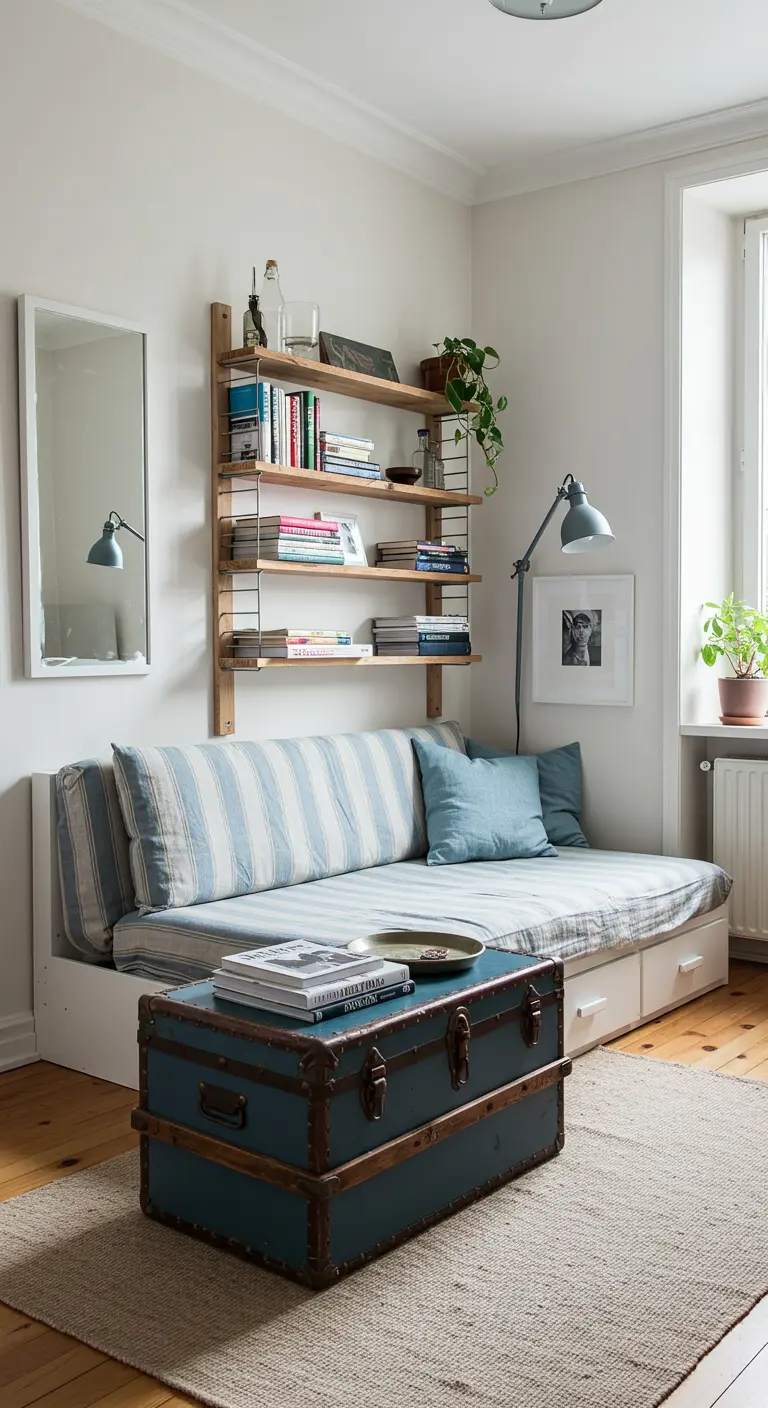
An old steamer trunk brings a sense of history, character, and much-needed storage to your living room.
Its sturdy, flat top makes it a perfect coffee table, while the interior is ideal for stashing away blankets, magazines, or remote controls.
The worn leather and metal hardware provide a rich textural contrast to a soft daybed and a simple jute rug.
This is one of the easiest ways to introduce a piece with a story into your home, adding that vintage soul that makes a space feel unique.
16. Anchor Your Space with Intricate Carvings
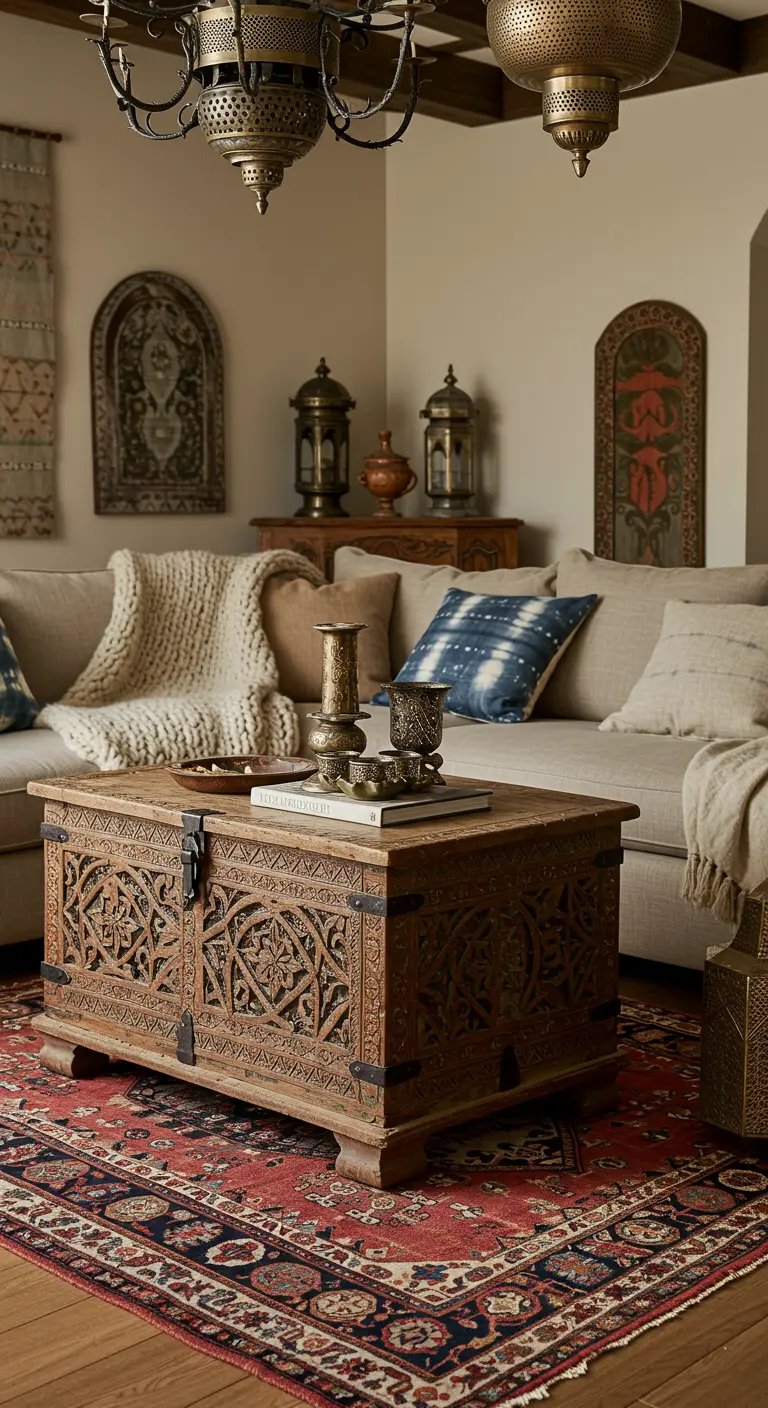
Infuse your living room with global character by choosing a coffee table with intricate, handcrafted details.
A heavily carved wooden chest, like this Moroccan-inspired piece, acts as a functional sculpture and a powerful focal point.
Balance its visual weight with soft, neutral furnishings and textured throws, allowing the table’s artistry to shine.
Look for authentic pieces at flea markets or import stores to bring a sense of travel and history home, creating a look similar to Moroccan-style interiors.
17. Ground a Light Room with a Dark Fireplace
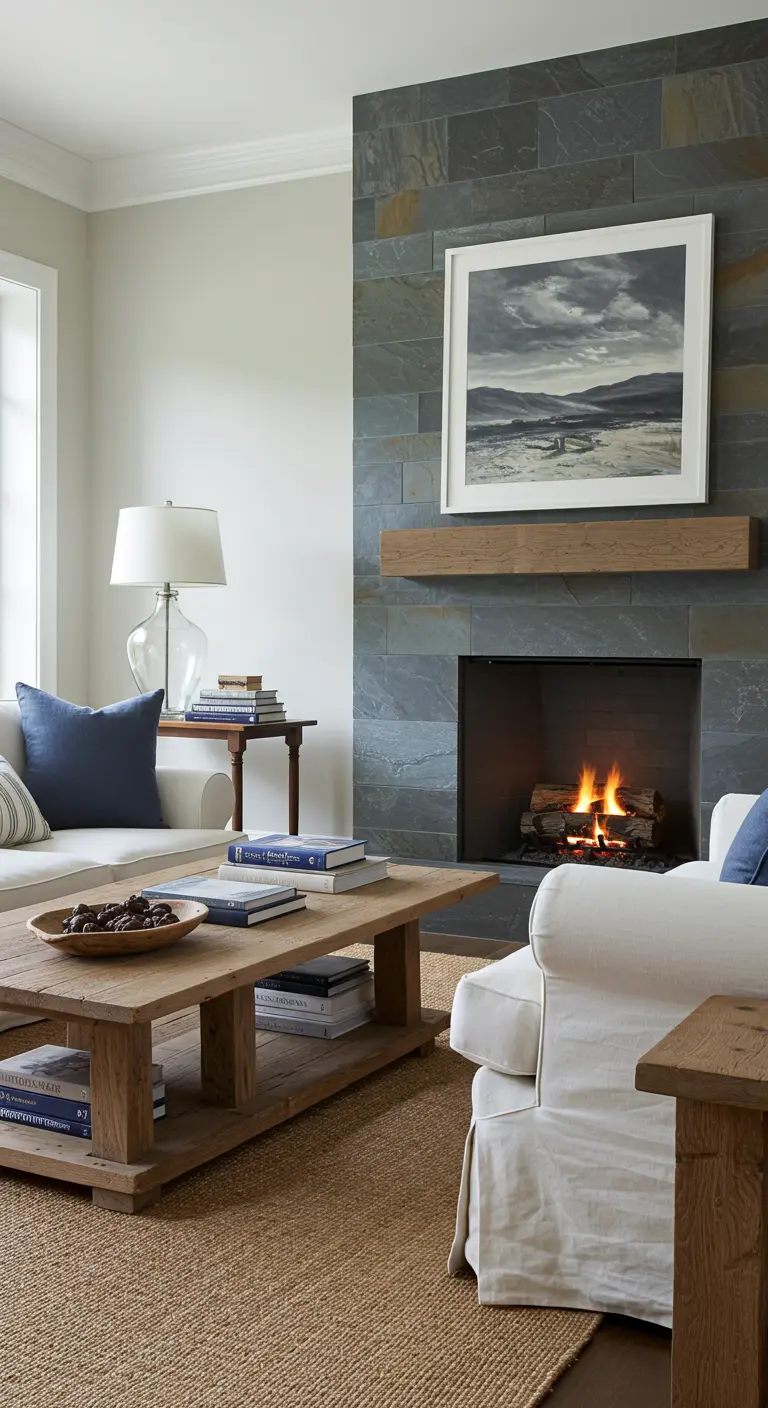
In a light and airy living room, create a strong, modern anchor by cladding the fireplace in dark slate tiles.
The deep, matte color and subtle texture provide a dramatic contrast to pale walls and soft linen furniture.
A simple, floating wood mantel adds a touch of warmth and breaks up the expanse of stone.
This high-contrast feature draws the eye and gives the room a sophisticated focal point, a technique often used in high-contrast small spaces.
18. Embrace Serenity with a Plaster Art Piece
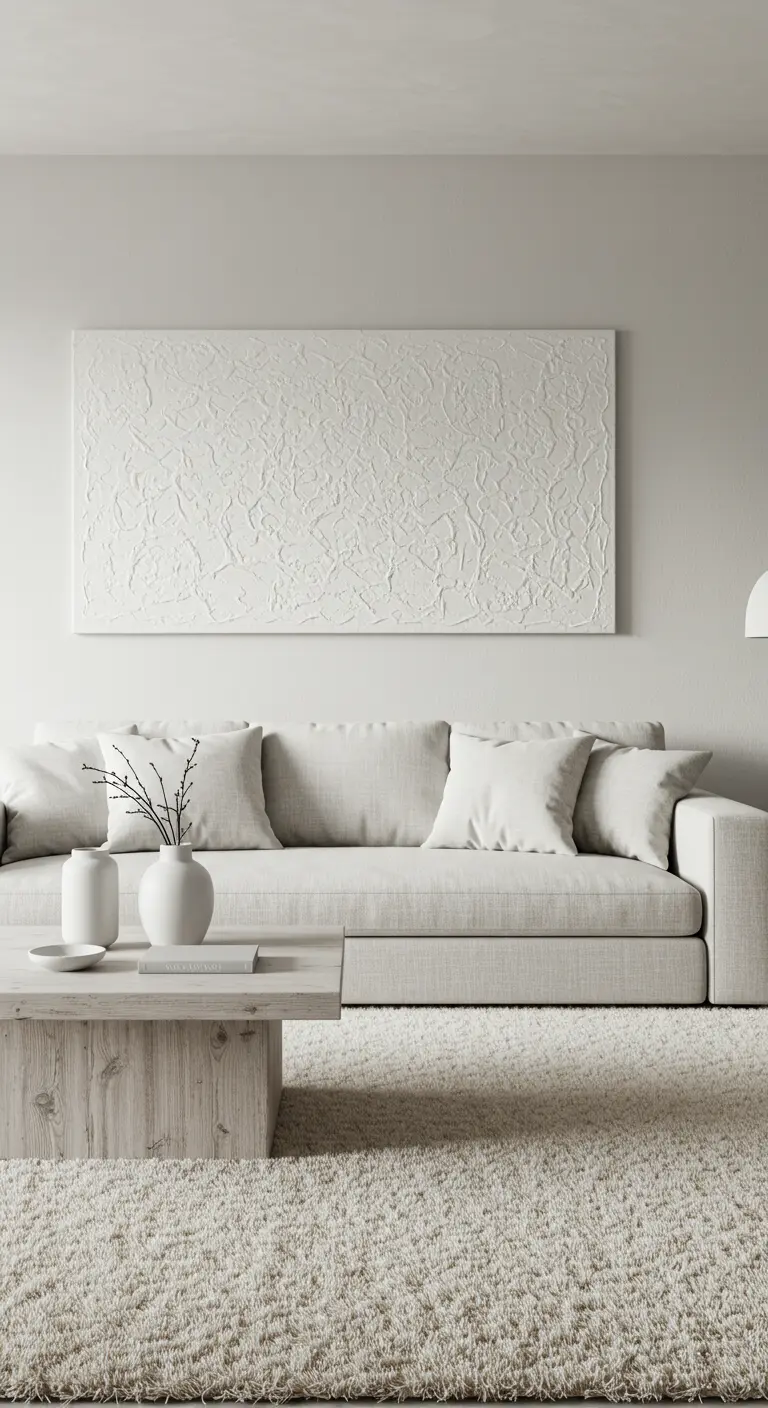
For artwork that provides texture without color, choose a dimensional plaster or textile piece in a monochrome palette.
This type of art creates interest through shadows and highlights, shifting subtly as the light changes throughout the day.
It fosters a serene, gallery-like atmosphere that is calming and sophisticated.
Paired with a light wood table and soft fabrics, it completes a space dedicated to quiet contemplation, a core idea in perfecting the greige aesthetic.
19. Hang Curtains High and Wide for a Grand Effect
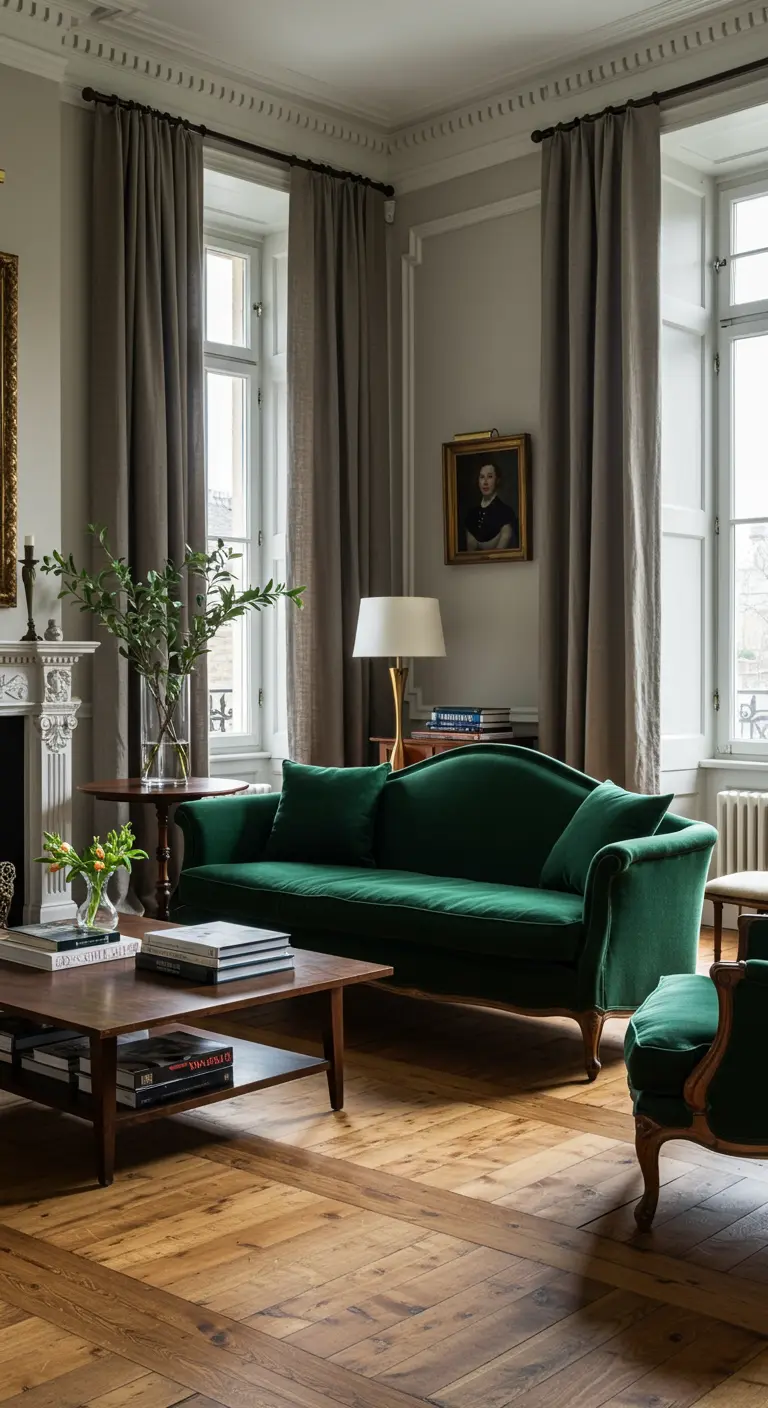
Make your windows feel larger and your ceilings taller with a simple curtain trick.
Mount the curtain rod several inches above the window frame and extend it well beyond the sides.
This creates the illusion of a much grander window and allows the maximum amount of light in when the curtains are open.
Use a substantial fabric like heavy linen or velvet to add a touch of drama and elegance, a technique that works wonders in small spaces that need to feel larger.
20. Suspend a Fireplace for an Uninterrupted View
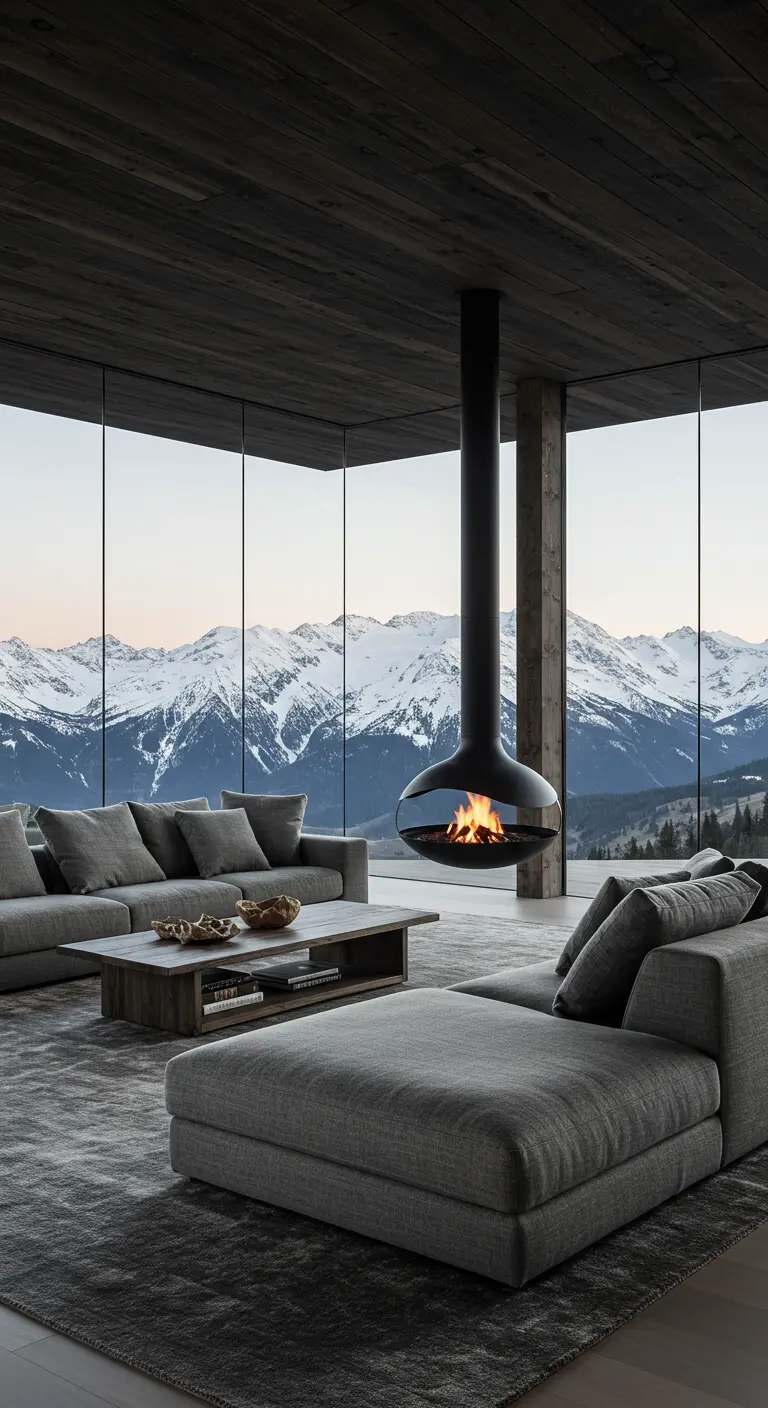
In a room with floor-to-ceiling glass and a breathtaking view, a traditional fireplace would block the scenery.
A suspended fireplace, hanging from the ceiling, provides warmth and a focal point without creating a visual barrier.
Its sculptural, modern form becomes a piece of art in itself, enhancing the room’s contemporary feel while allowing the landscape to remain the star.
This is the ultimate solution for refined contemporary rooms where the view is paramount.
21. Mount Abstract Art on a Reclaimed Wood Wall
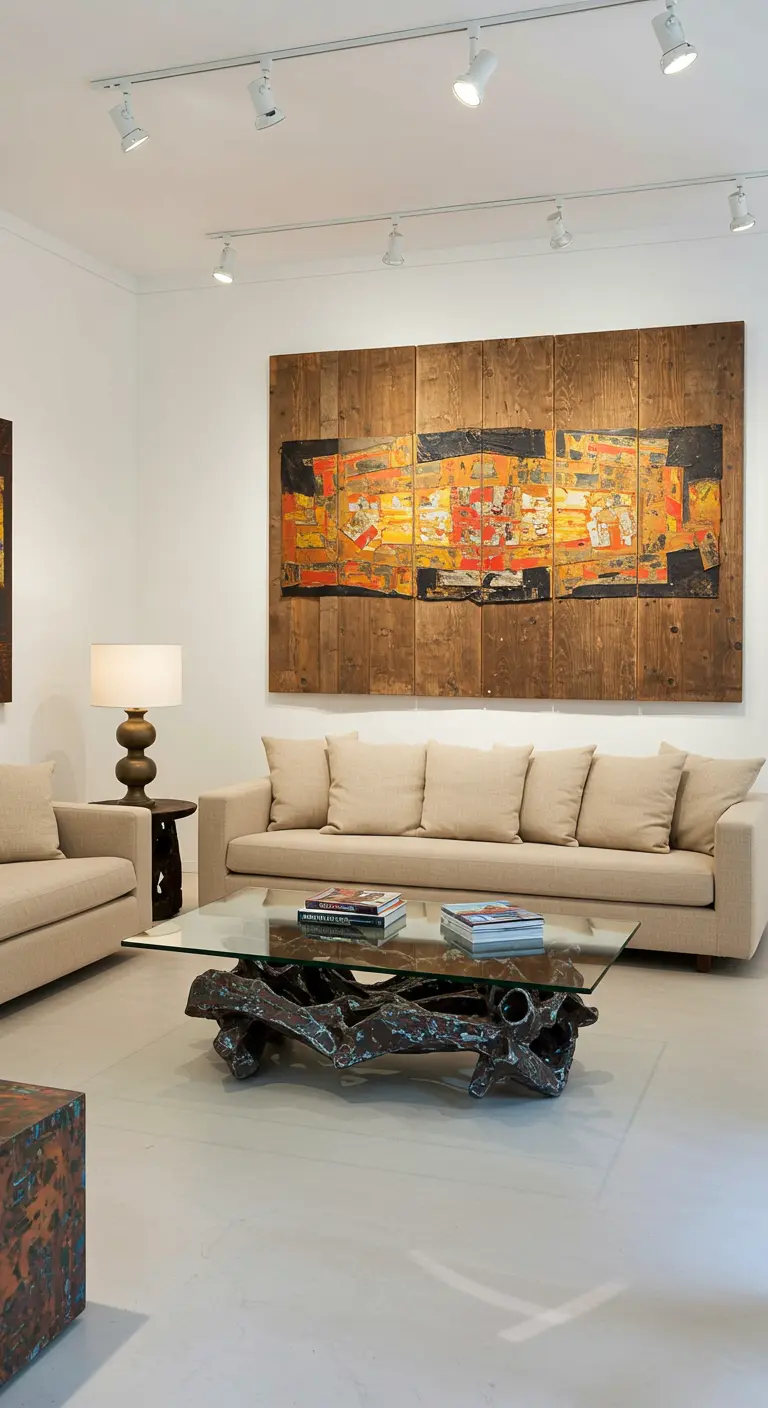
Create a powerful juxtaposition by mounting bold, abstract art directly onto a rustic, reclaimed wood wall.
The smooth, graphic nature of the artwork provides a striking contrast against the rough, organic texture of the wood.
This layering of old and new, raw and refined, creates a dynamic focal point that feels curated and deeply personal.
The glass-topped table with a sculptural base continues this theme of contrasting materials, turning the room into a compelling gallery space.
22. Use Patterned Ceramics for a Classic Pop
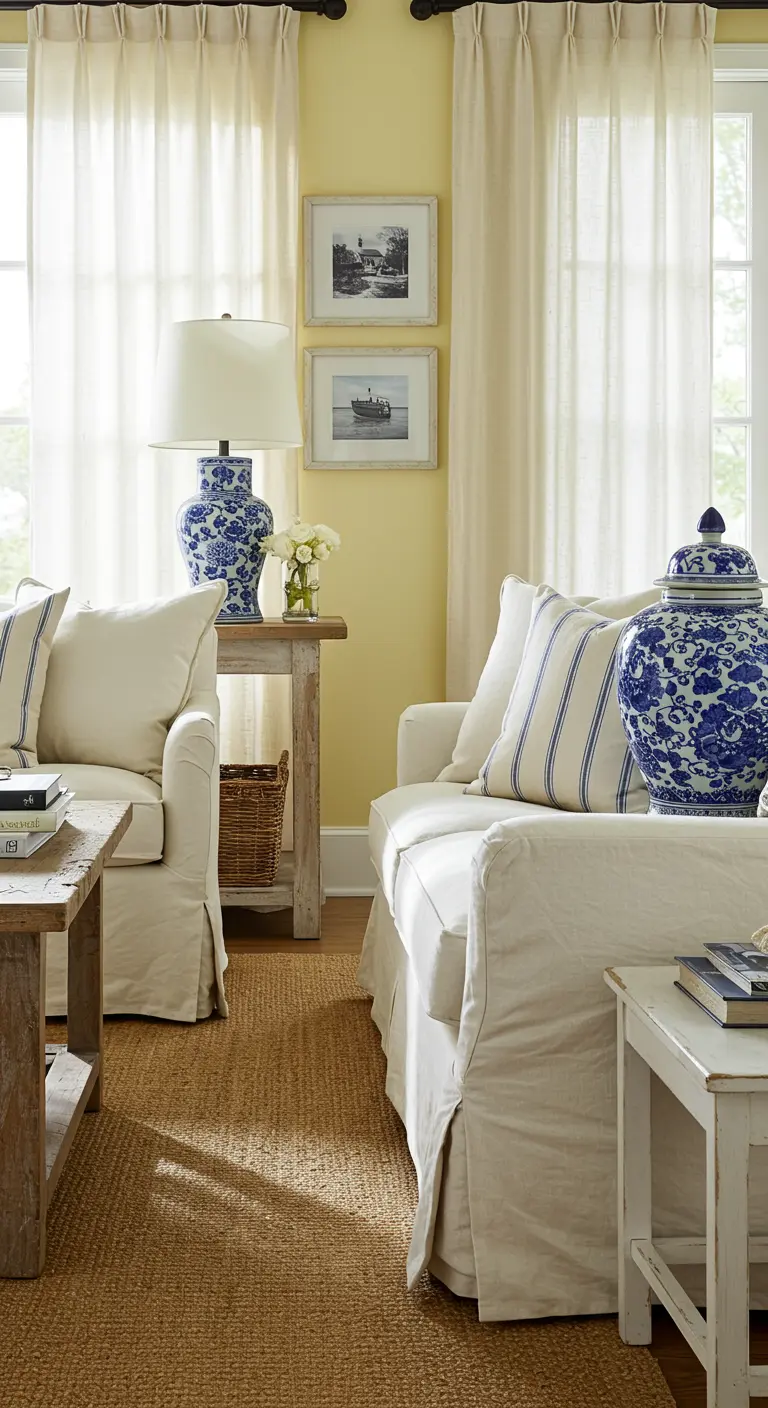
Inject classic elegance and a touch of color into a neutral room with blue-and-white chinoiserie porcelain.
A pair of large ginger jars or a shapely lamp base can serve as a striking accent, breaking up the sea of beige and white.
The timeless pattern feels sophisticated and collected, adding a layer of tradition to a relaxed, coastal-inspired space.
It’s a simple swap that can make coastal-inspired spaces feel more layered and personal.
23. Turn Your Library into a Coffee Table
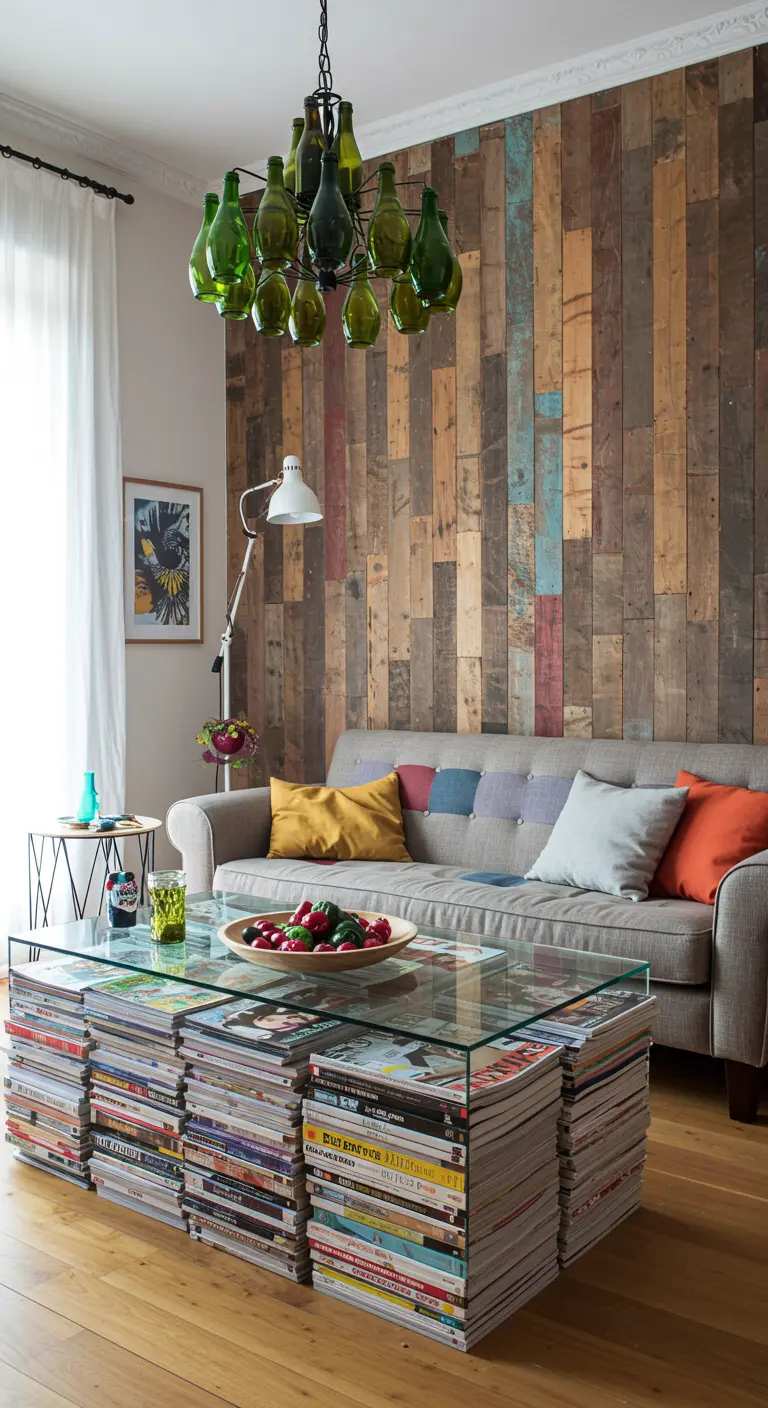
For a bold and personal statement, create a coffee table base from stacks of your favorite art books or magazines.
To make this look intentional, ensure the stacks are perfectly level and uniform, then top them with a heavy pane of glass.
This unconventional approach turns your reading material into a piece of installation art and is a fantastic conversation starter.
It’s a clever idea for upcycled DIY table decorations that showcases your personality.
24. Conceal Technology with Integrated Cabinetry

Maintain a serene, uncluttered atmosphere by integrating your media storage into a seamless wall of dark cabinetry.
This approach hides cords, consoles, and clutter behind clean, minimalist doors, allowing the television to blend into the dark surface when not in use.
The result is a sophisticated and calming media wall that feels like an intentional architectural feature, not just a place for electronics.
This technique is essential for creating clean-cut minimalist studios and homes.
25. Design Seating to Follow the Room’s Architecture
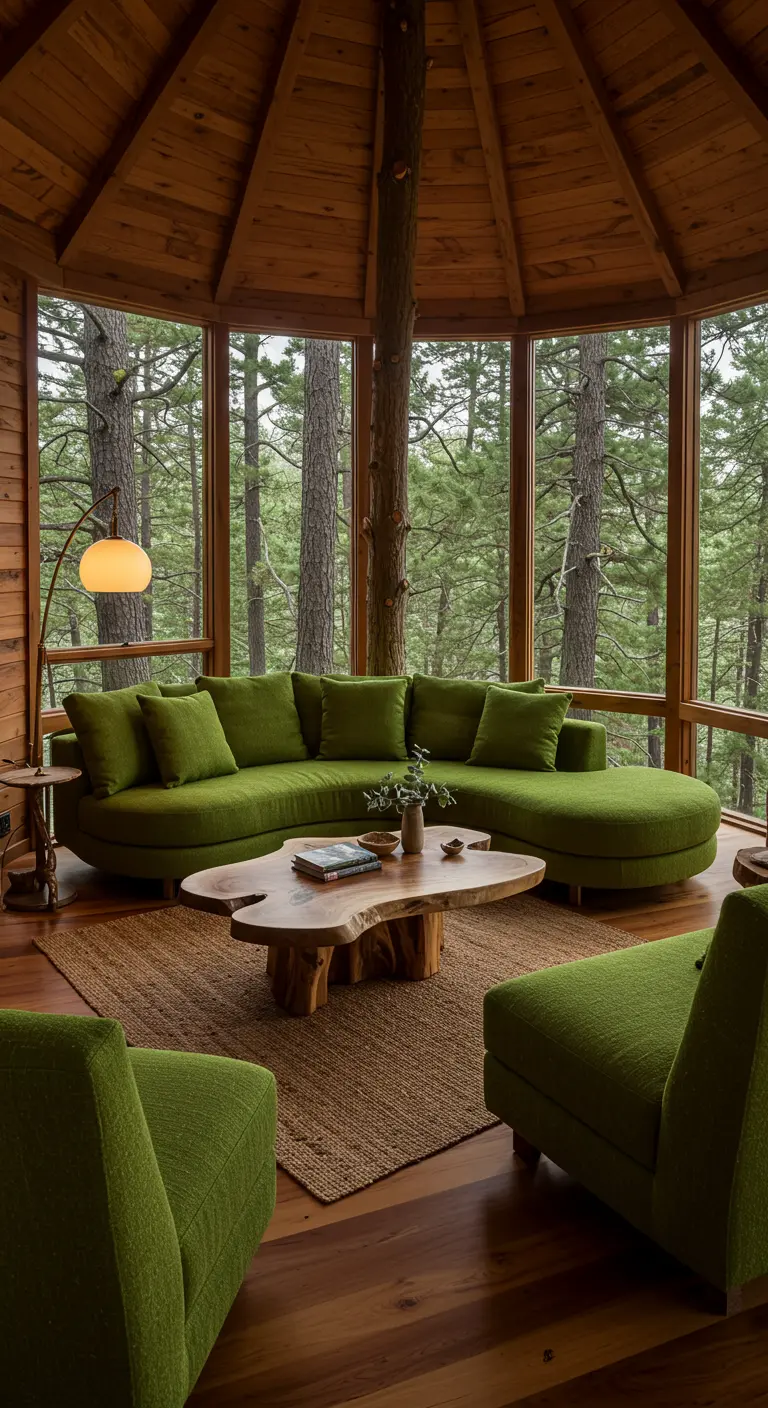
In an unusually shaped room, like this octagonal space, a standard sofa will feel awkward and out of place.
Instead, choose or commission a curved sectional that follows the lines of the walls.
This creates a harmonious, flowing layout that maximizes seating and makes the entire space feel cohesive and intentional.
It’s a smart solution for making the most of unique architectural features, especially in a forest-like setting.
26. Unify a Space with a Single Material
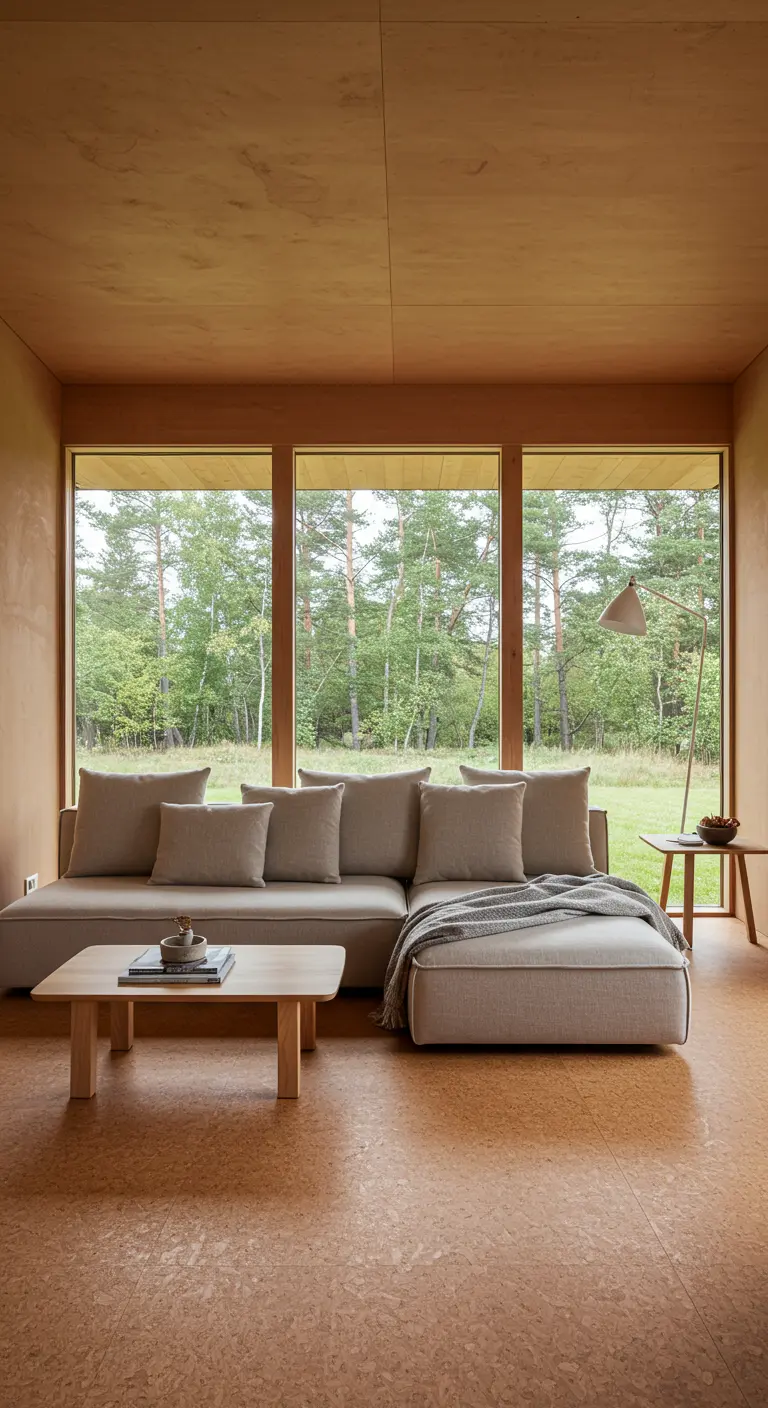
For a truly immersive and serene environment, use one material—like this light plywood—for the walls, ceiling, and even flooring.
This technique, known as ‘material cocooning,’ creates a seamless, minimalist envelope that is incredibly calming and visually clean.
The simplicity of the backdrop allows the view from the large window and the soft textiles of the furniture to become the room’s main features.
This is a core principle of warm minimalist spaces, where simplicity creates the ultimate luxury.
27. Create Architectural Interest with Wall Niches

Instead of adding furniture for display, build niches directly into the wall.
These arched alcoves provide a beautiful, sculptural home for pottery, art, and other cherished objects, turning them into integrated features of the room.
This approach keeps the floor clear and maintains a clean, uncluttered look, perfect for a Mediterranean-inspired interior.
The built-in banquette seating continues this theme of furniture as architecture.
28. Build Industrial Shelving for Form and Function
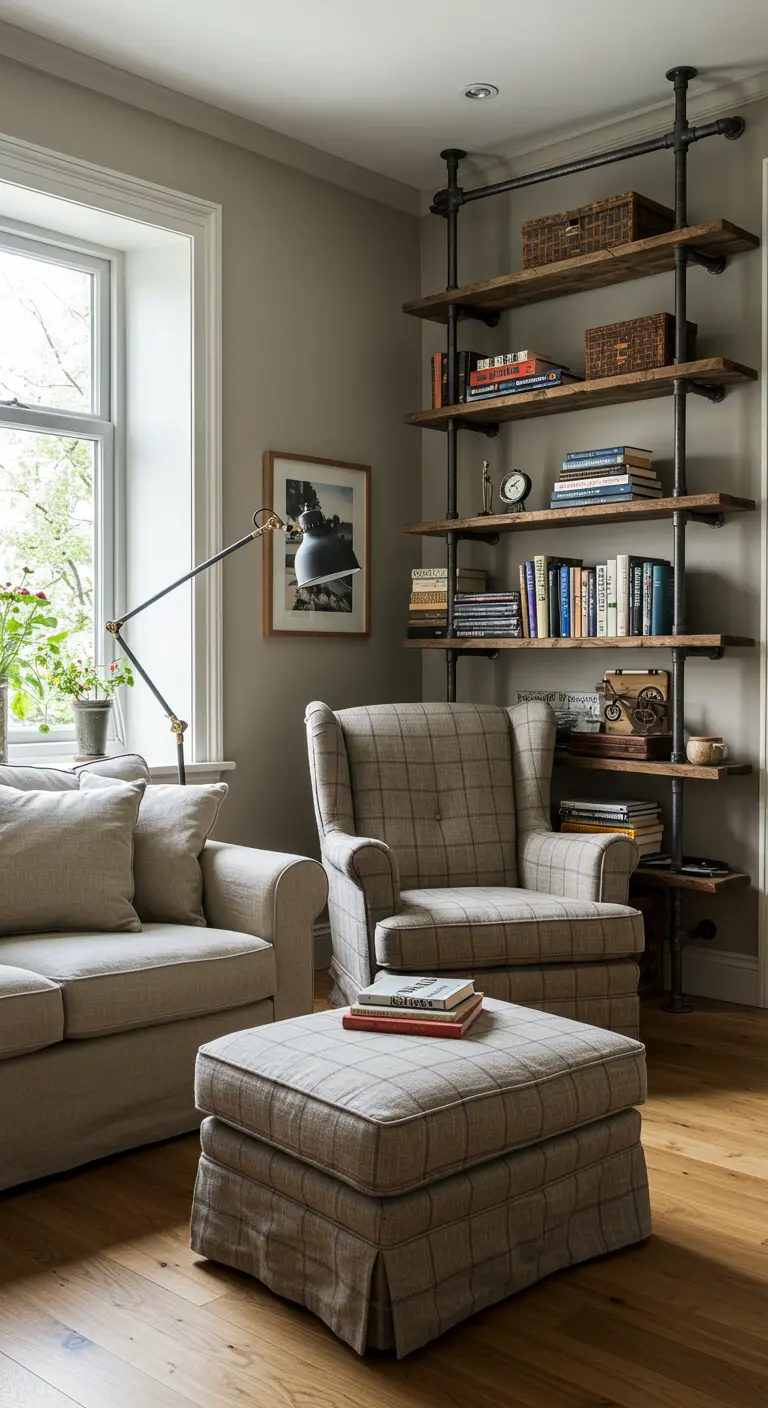
For a storage solution that is both practical and stylish, construct open shelving using reclaimed wood planks and industrial metal pipes.
This type of shelving adds a raw, urban edge to a classic room and provides ample space for books and decor.
To keep it from looking cluttered, style it with intention: group similar items, leave some empty space, and mix vertical books with horizontal stacks.
This look is a signature of farmhouse-industrial fusion.
29. Add Practicality with Hidden Storage Baskets

A rustic coffee table with a lower shelf is the perfect place to tuck away large woven baskets.
This provides discreet, accessible storage for everything from extra throws to children’s toys, keeping your living room tidy without sacrificing style.
Choose baskets made from natural fibers like jute or seagrass to complement the wood and add another layer of texture to the room.
This is a simple, effective way to add storage to nature-inspired small spaces.
30. Use Charred Wood for Unmatched Textural Depth
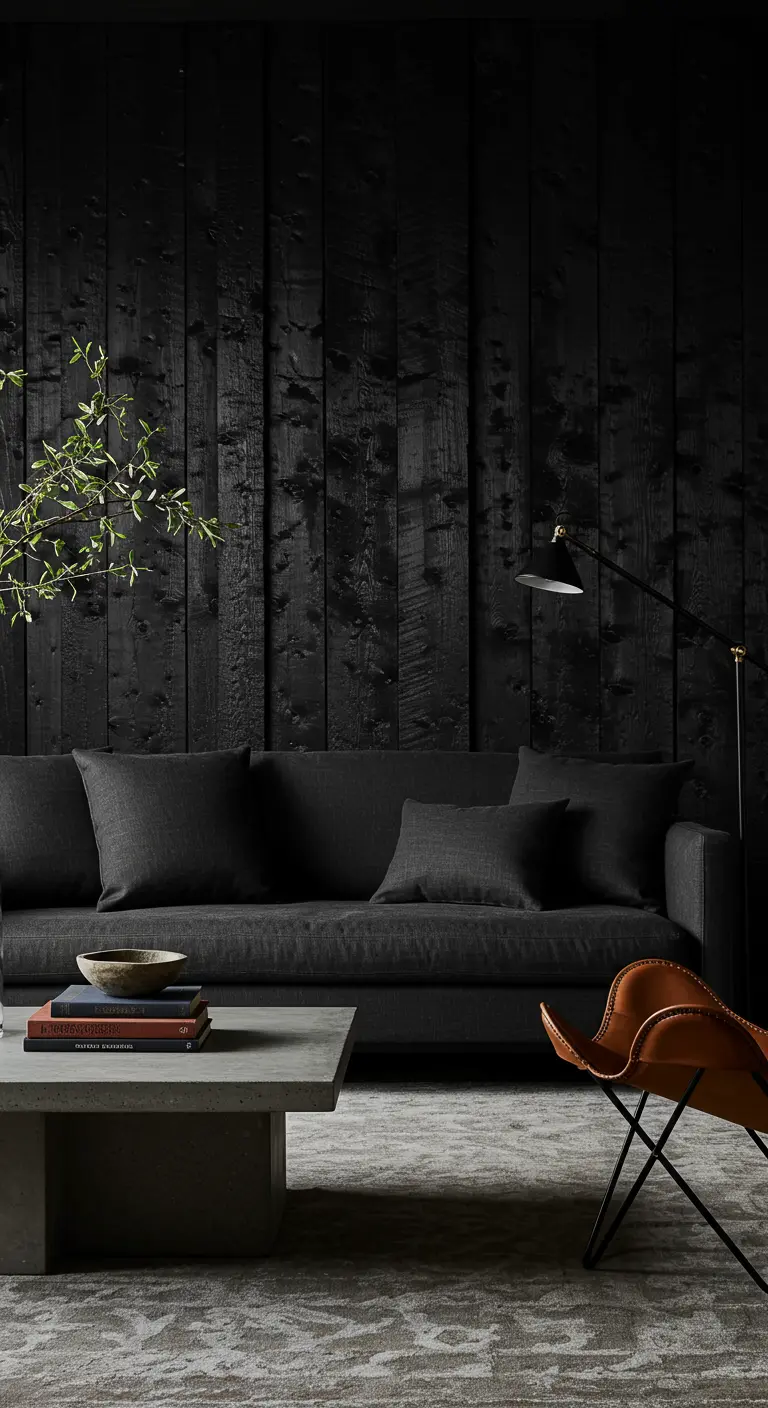
For a truly dramatic and sophisticated accent wall, use Shou Sugi Ban, the Japanese art of charring wood.
This technique preserves the wood while creating a deep, crackled, charcoal-black finish with a subtle silver sheen.
The incredible texture makes a powerful statement, so keep the rest of the palette dark and monochrome to let the wall be the focus.
A single leather chair adds another layer of rich, natural material, perfecting these moody small spaces.
31. Maximize Charm in a Compact Space
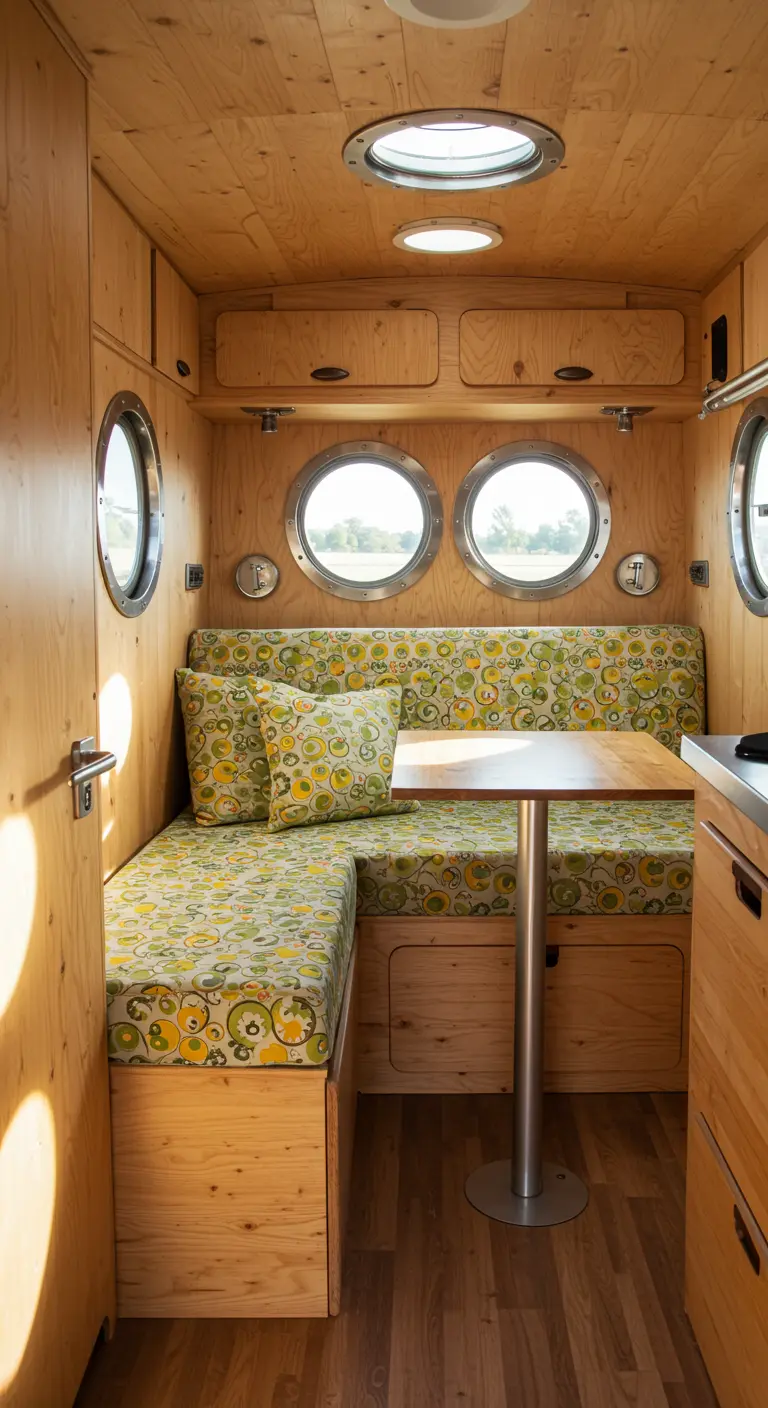
In a very small space like a camper or tiny home, built-in furniture is essential.
A custom-built banquette provides comfortable seating and allows for hidden storage underneath.
Choose a playful, retro-inspired fabric to add personality and make the small nook feel special and inviting.
The all-wood interior and charming porthole windows enhance the cozy, nautical feel, showcasing how elevated studio apartment designs can be applied anywhere.
32. Create a Gallery Wall with Antique Plates
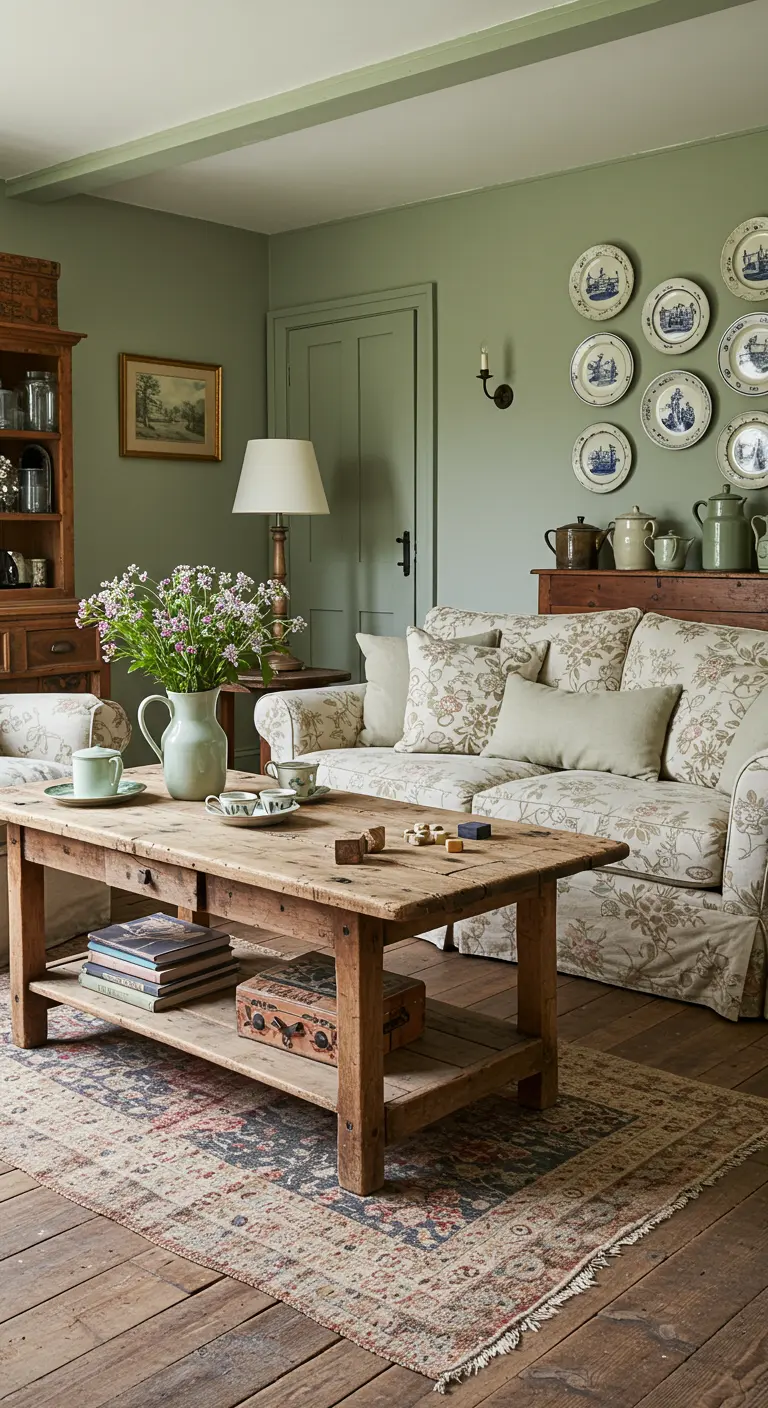
For a charming, country-inspired alternative to framed art, create a gallery wall using antique ceramic plates.
Arrange them in a loose, organic cluster above a console table or sofa for a collected, unfussy look.
Stick to a cohesive color palette, like these blue-and-white transferware plates, to ensure the display feels curated, not chaotic.
This adds a touch of history and personality, perfect for a French country interior.
33. Design an Open-Air Room That Blurs Boundaries
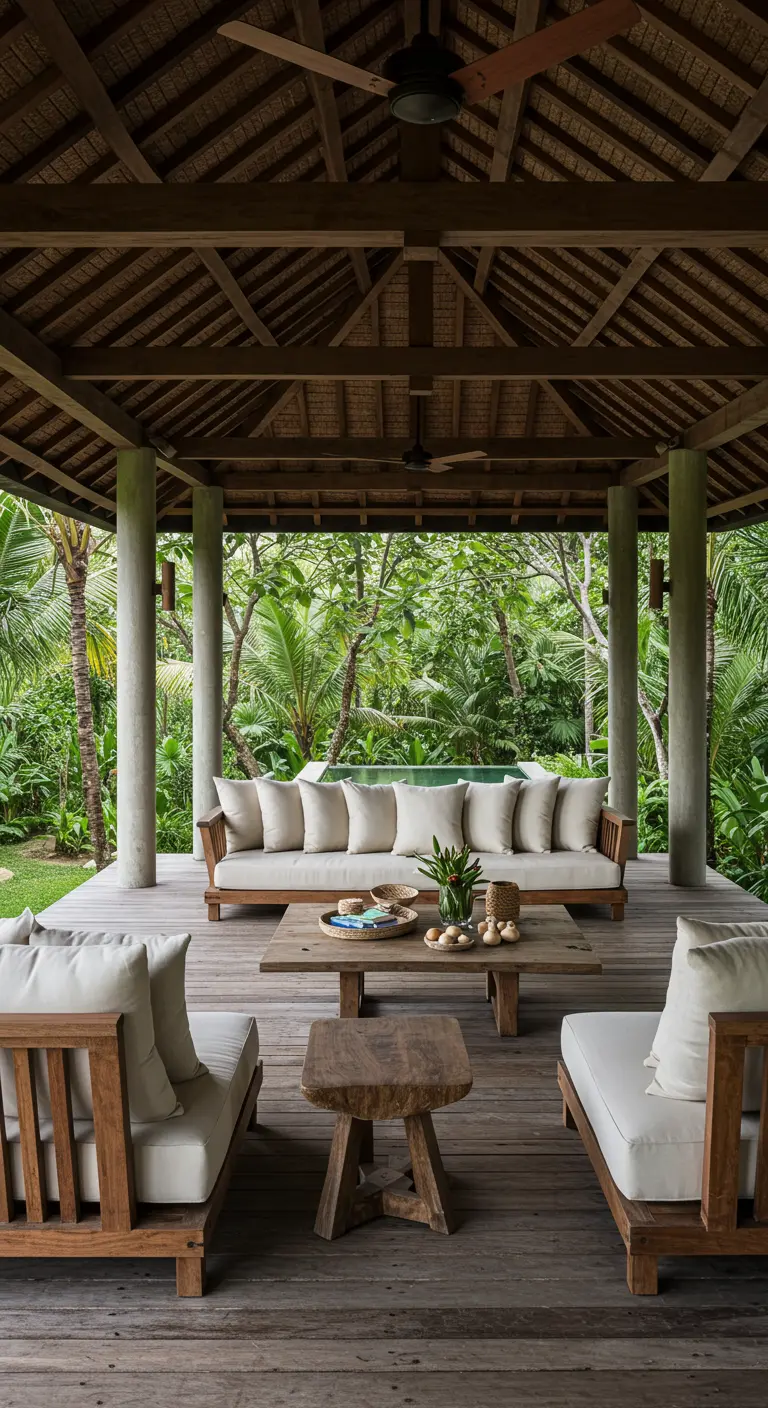
Create a seamless transition between indoors and out by designing a covered living area that feels like a true extension of your home.
Use durable but comfortable outdoor furniture with deep cushions, and ground the space with a substantial wood coffee table.
The covered roof provides shelter, while the lack of walls allows for an immersive experience with the surrounding nature, ideal for creating tropical teak daybeds and lounge zones.

